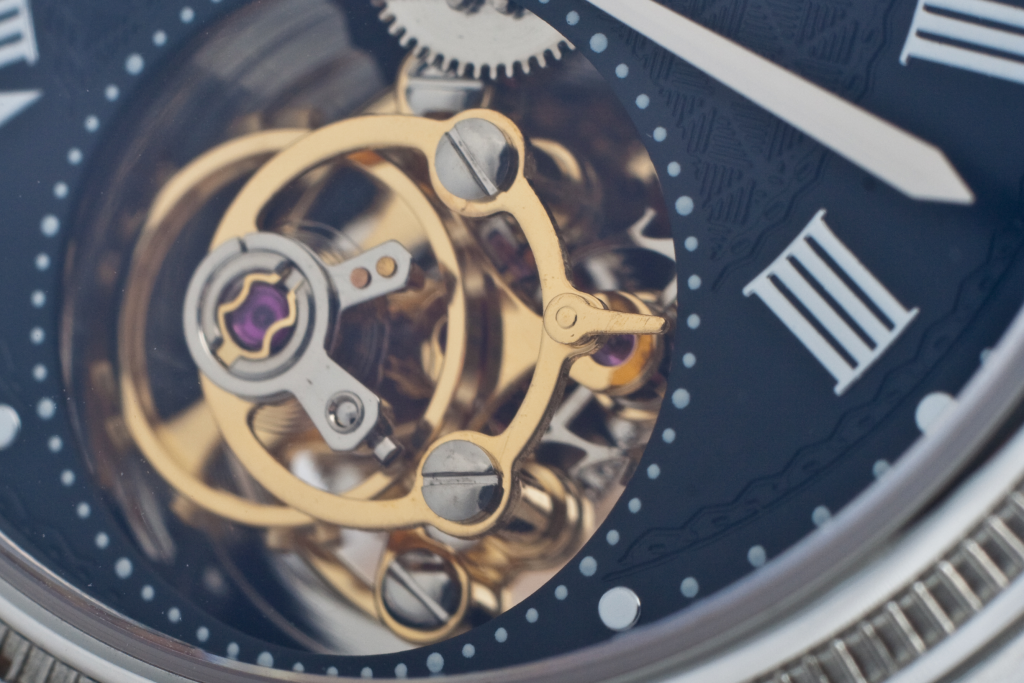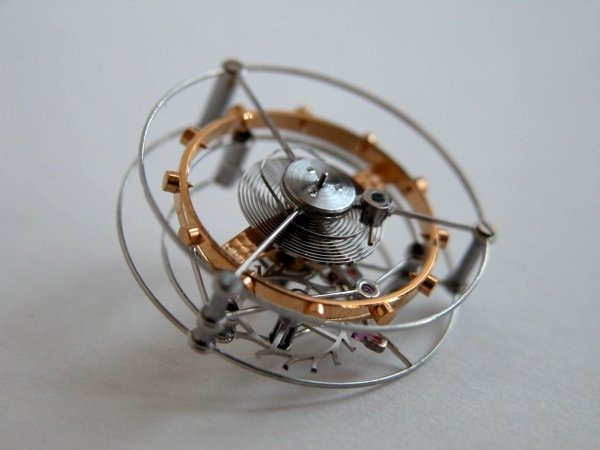Article written by Alexander – Founder and Owner of swissdiverswatches.com
Encyclopedia Of Horology
If you are looking for information on Swiss Luxury Watches you have come to the right place. Here you’ll find more than 50 answers to more than 50 frequently asked questions!
This page serves as an encyclopedia and a list of recommendations.
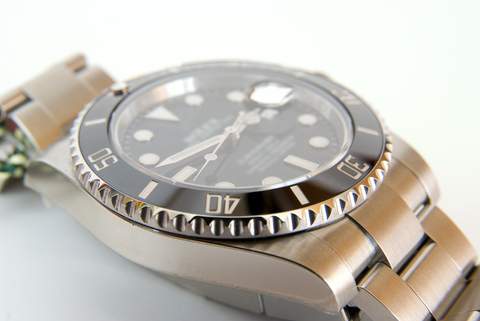
When you visit an authorized physical luxury watch dealer, or an online watch retailer, it’s important that you are well informed on the plethora of technical information, that you’ll find in conjunction with your watch purchase: definitions, technical terms, expressions and suchlike, that are frequently used to describe qualities, features, functions and movements of Swiss luxury watches.
For this reason, I have compiled a list of the most frequently asked questions concerning Swiss Luxury Watches on and off the Internet – and one question – nr 6, which concerns this website.
51 Frequently Asked Questions & Answers:
- Why is it important that a watch is Swiss Made?
- What organization sets the criteria for a watch being Swiss Made?
- What is a Swiss watch?
- What determines if the movement is Swiss or not?
- What is the difference between a “Swiss Made timepiece” and a timepiece containing a “Swiss movement”?
- Does swissdiverswatches.com promote Swiss Made watches, watches with Swiss movements or both?
- In what parts of Switzerland are most watch manufacturers and brands located?
- What are the advantages and disadvantages of independent Swiss watch brands and manufacturers?
- What are the advantages and disadvantages of Swiss watch brands being subsidiaries?
- Who are the main manufacturers and owners of the Swiss watchmaking industry?
- What is a Divers Watch?
- What is the ISO-6425 international standard?
- What do the various water resistance levels actually mean?
- What is a “unidirectional bezel”?
- How does the bezel work?
- What are quartz, automatic and mechanical movements?
- What do automatic and mechanical movements look like?
- What is the history of quartz, automatic and mechanical movements?
- What maintenance does my watch need?
- What is the difference between a chronograph and a chronometer?
- Are all Swiss Made watches chronometers?
- Does the “chronometer” denomination apply to quartz watches as well?
- What is the difference between “Chronometer”, “Certified Chronometer”, “Chronometer Certified” and “Superlative Chronometer”?
- Just how accurate are mechanical, automatic and quartz movements?
- What is a tachymeter?
- What is sapphire crystal glass?
- What do “T Swiss Made T”, “Swiss T 25”, and “L Swiss Made L” mean?
- What does a luminescent dial look like?
- Can I clean or wash my timepiece in the comfort of my own home?
- Why are some watches more expensive than others?
- Why are some watch cases thicker whereas other cases are thinner?
- What is a mainspring?
- What is an escapement?
- What is a balance wheel?
- What is a hairspring?
- What are watch movement jewels?
- What is vph?
- What is a power reserve?
- What is a power reserve indicator?
- What is an in-house watch movement?
- What is an ETA movement?
- What is a Valjoux movement?
- What is a Sellita movement?
- What is a decorated movement?
- What is GMT?
- What is Haute Horlogerie?
- What are Astronomical Complications?
- What are Striking Complications?
- What are Timing Complications?
- What is a Grande Complication?
- What is a Tourbillon?

1. Why is it important that a watch is Swiss Made?
In 1541 the Swiss watch industry was born, and ever since, Switzerland – the small landlocked wealthy and affluent central European nation located in the picturesque Alps – has been the center of the world’s watchmaking industry.
The designation “Swiss Made” or in short form “Swiss”, implies a rock solid reputation across the world. When a watch is “Swiss Made” it implies impeccable unmatched world class quality.
Made” it implies impeccable unmatched world class quality.
The quality fundamentally refers to: the technical quality and the aesthetic quality.
The technical quality would include several technical characteristics such as water-resistance, reliability, accuracy and shock-resistance. The aesthetic quality implies that Swiss timepieces have original and elegant designs.
The very fact that a watch has the denomination “Swiss Made” on it, guarantees a solid global reputation among all watchmakers. Swiss watchmakers are renowned for their expertise, innovation, handicraft, and the use of high quality materials.
The Swiss are known for their hard and very thorough work, and they are known to manufacture products of perfection and impeccable and unmatched quality, accuracy, reliability and durability.
The Swiss enjoy a completely dominant role in the luxury watch industry.
Tiny Switzerland with merely 8 million inhabitants, is the world leader in value terms (in USD billion). In USD billion, Swiss exports exceed the value of the watches manufactured by Hong Kong, China, France and Germany combined.
This includes both basic watches such as Swatch and Flik Flak, and Swiss luxury watches such as Rolex, Jaeger LeCoultre, Omega, Breitling, IWC Schaffhausen, Audemars Piguet, Patek Philippe or Breguet – just to mention a few examples.
Among the top 30 luxury wrist watch brands in the world, I’d say that probably 25 of them are Swiss.
Switzerland is so dominant in the luxury watch industry, that a Swiss timepiece and a luxury timepiece are almost synonymous.
Back To The Frequently Asked Questions & Answers Menu
2. What organization sets the criteria for a watch being Swiss Made?
The Federation of the Swiss Watch Industry FH sets the criteria for whether or not a timepiece is Swiss made. In the picture below you see the denomination “Swiss Made”. Only genuine and authentic Swiss timepieces are allowed to bear this denomination.
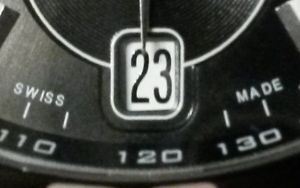
Back To The Frequently Asked Questions & Answers Menu
3. What is a Swiss watch?
According to the Federation of the Swiss Watch Industry FH, there are three main criteria for a watch manufacturer or watch brand being Swiss:
- the movement needs to be Swiss;
- the movement needs to be cased up in Switzerland;
- the watch manufacturer performs the final inspection geographically in Switzerland.
It means that if a watch brand or manufacturer does not fulfill all three abovementioned requirements, it is not considered to be a genuine Swiss brand. Only a genuine Swiss watch may carry the term “Swiss” or “Swiss Made”.
Back To The Frequently Asked Questions & Answers Menu
4. What determines if the movement is Swiss or not?
According to the Federation of the Swiss Watch Industry FH, there are three main criteria to determine whether or not the movement is Swiss:
- the movement needs to be assembled geographically in Switzerland;
- the movement has been inspected by the watch manufacturer in Switzerland;
- the constituent parts of Swiss fabrication need to constitute a minimum of 60% of the total value, excluding the cost of assembly.
It means that if a watch brand or watch manufacturer does not fulfill all three abovementioned requirements, the movement isn’t considered to be Swiss, and if the movement isn’t Swiss, the timepiece isn’t Swiss either. The Swiss origins of the movement are essential in determining whether or not the watch is truly Swiss.
Back To The Frequently Asked Questions & Answers Menu
5. What is the difference between a “Swiss Made timepiece” and a timepiece containing a “Swiss movement”?
Here is usually where much of the misunderstandings occur. There are particular cases in which the movement itself fulfills these conditions – that is to have a sufficient amount of Swiss components that account for at least 60% of the value of the movement, yet the watch is not assembled geographically in Switzerland. In that case, the term “Swiss” may appear on one of the components of the movement. On the outside of the watch, the indication “Swiss movement” or “Mouvement Suisse” may appear.
“Swiss movement” and “Swiss Made” are thus not the same. It’s important to differentiate between these two terms.
“Swiss movement” means that components or parts of the watch have Swiss origins.
“Swiss Made” means the movement and the timepiece all together are indeed a genuine Swiss Product.
Below you see examples to illustrate this.
A “Swiss Movement Watch”. This isn’t a Swiss watch. In the picture below you’ll notice that this is an Invicta watch. The “Swiss Made” denomination is missing on the dial.
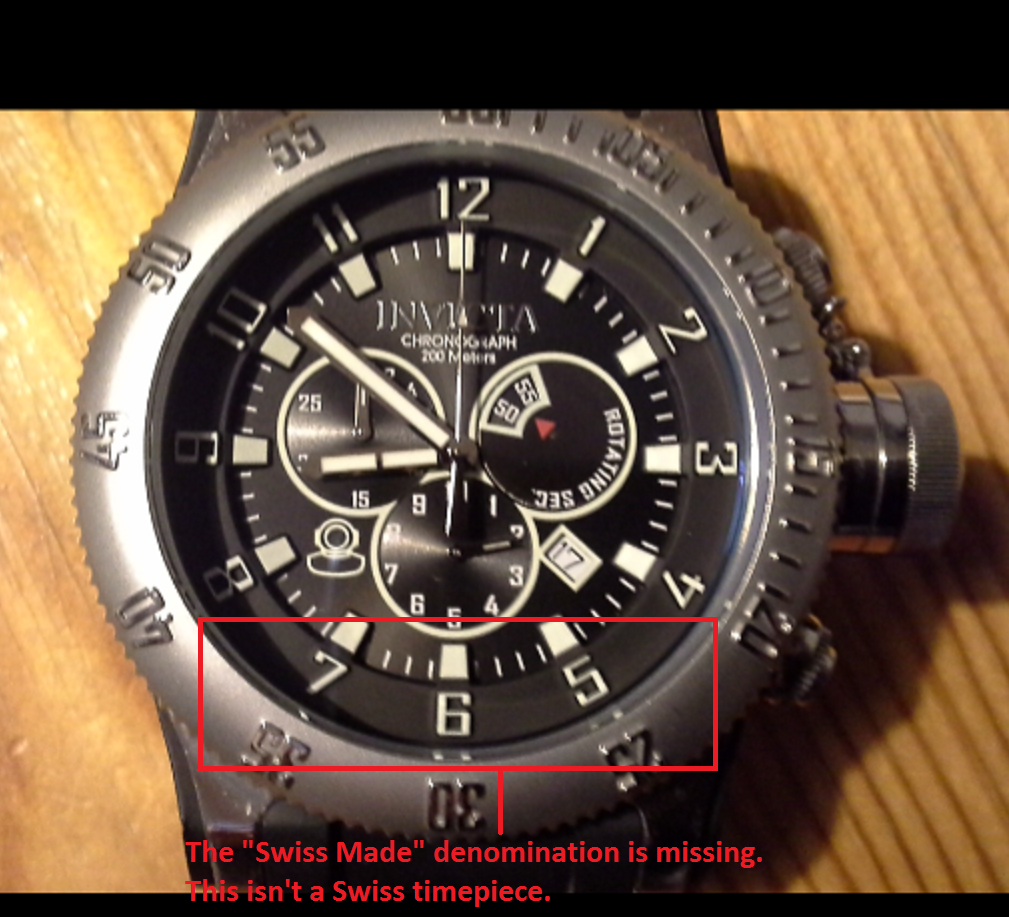
If you take a look at the caseback, you see the denomination “Swiss Parts” – it means only parts of the watch or the movement have Swiss origins. This means that this isn’t a Swiss watch since it doesn’t explicitly say “Swiss Made”.
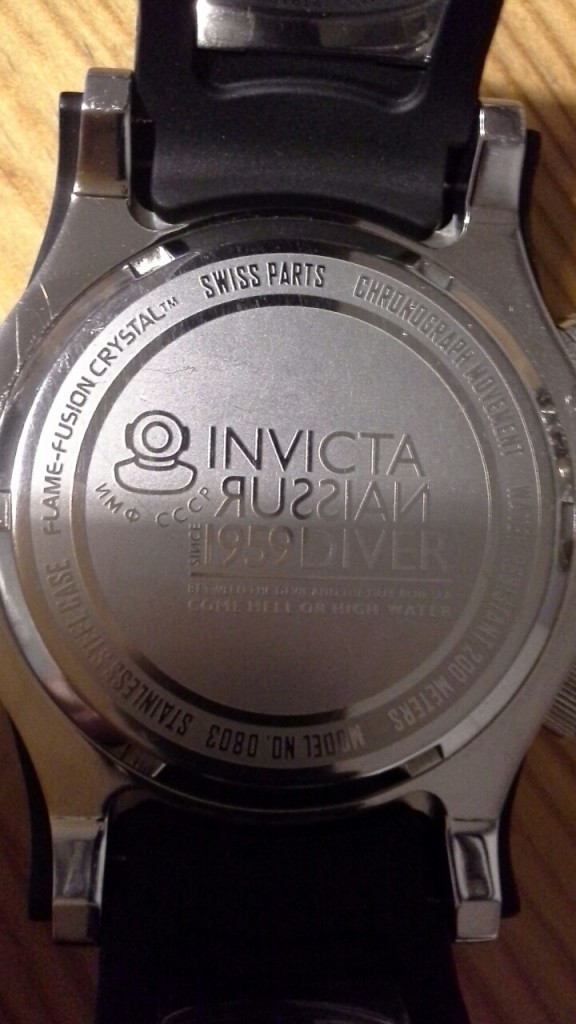
Below – A genuine Swiss Made timepiece: In the picture below you see an example of a genuine Swiss watch/brand: Certina DS Action Quartz. On the bottom of the dial you can clearly see the denomination “Swiss Made”.
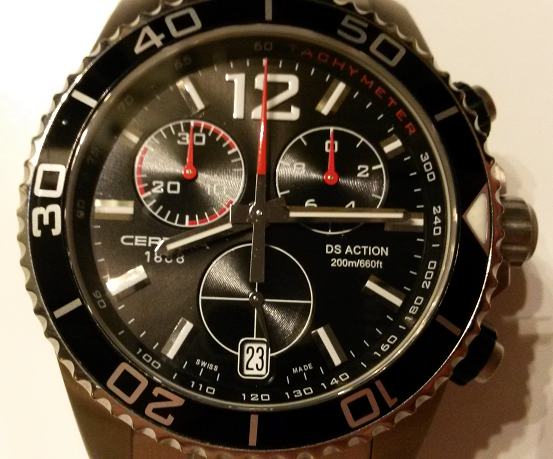
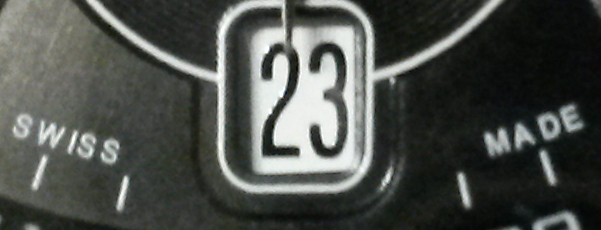
Back To The Frequently Asked Questions & Answers Menu
6. Does swissdiverswatches.com promote Swiss Made watches, watches with Swiss movements or both?
“Swiss Made” and “Swiss movement” are thus not the same. It’s important to differentiate between these two terms.
“Swiss Made” means the movement and the timepiece all together are indeed a genuine Swiss product.
“Swiss movement” means that components or parts of the watch have Swiss origins.
Since I know from personal experience that people desire quality timepieces, and more specifically Swiss Made timepieces, I’ve decided that this website will be dedicated only to Swiss Made watches. All timepieces and all watch brands that are promoted here at swissdiverswatches.com are indeed genuine Swiss Made watches.
Every single brand, manufacturer and watch displayed at this website, bears the proud designation “Swiss Made”.
Back To The Frequently Asked Questions & Answers Menu
7. In what parts of Switzerland are most watch manufacturers and brands located?

Most Swiss wristwatch brands and manufacturers, are located in Western Switzerland (the French speaking part of Switzerland), in the regions of:
- Jura
- Neuchâtel
- Vaud
- Geneva.
All of these regions are in close proximity to the French border. The most prestigious watchmaking region is Geneva. That’s where you’ll find Patek Philippe and Rolex.
The dominant language of the Swiss watchmaking industry is French.
Despite that Switzerland has four official languages (German, French, Italian and Romansh), French is the dominant language of the Swiss watchmaking industry, since most Swiss wristwatch brands and manufacturers are concentrated to the Western, or the French speaking part, of the country. This indeed would include brands such as Rolex, Omega, Patek Philippe, Jaeger LeCoultre, Panerai, and Audemars Piguet – just to mention a few examples.
A few isolated Swiss watchmakers and brands can be found in the German speaking part of Switzerland – the most prominent example being IWC Schaffhausen in the small Swiss city of Schaffhausen. Unlike the majority of Swiss brands, where French is the dominant language, German is the main language of IWC Schaffhausen.
Back To The Frequently Asked Questions & Answers Menu
8. What are the advantages and disadvantages of independent Swiss watch brands and manufacturers?
Originally most Swiss watchmakers and brands were independent, but most of them have been purchased by a few influential industrial giants, corporate groups and conglomerates.
Some of these corporate groups and industrial giants are Swiss owned and some of them aren’t, but as long as the movements are manufactured, assembled and inspected in Switzerland, the brands are still considered to be Swiss, even if the owner isn’t.
Only a tiny minority of the Swiss wristwatch brands – including the luxury brands – are 100% independent. The vast majority act as subsidiaries of major corporate groups and conglomerates.
There are naturally both advantages and disadvantages of being an independent company and being a subsidiary.
The advantages of independent brands and manufacturers is that they have the unique privilege of defining their brand identity and setting the tone, strategy, course and direction of their company. Independent brands determine their research, organization, strategy, marketing and manufacturing techniques.
The disadvantages might involve lack of industrial and financial muscles and greater vulnerability when facing competition.
The independence of a Swiss watchmaker or brand, usually entails greater prestige, but there are in fact many cases where extreme luxury brands in fact function as subsidiaries.
Back To The Frequently Asked Questions & Answers Menu
9. What are the advantages and disadvantages of Swiss watch brands being subsidiaries?
The overwhelming majority of Swiss luxury wristwatch brands started as independent companies but ended up as subsidiaries – either for financial reasons or practical reasons.
The reasons for independent Swiss brands or manufacturers becoming subsidiaries, would involve for example: bankruptcy, scarce financial and industrial resources, tough competition, inability to develop, invent or manufacture a particular technology, inability to adapt to the market, lack of ideas and creativity etc.
There are many reasons, but the originally independent Swiss watchmakers obviously saw some advantages with becoming subsidiaries.
The advantage of being a subsidiary Swiss brand is that the subsidiaries may use the financial and industrial muscles of the parent company, and the subsidiaries enjoy greater financial security when facing competition. The subsidiary knows that the parent company and the other subsidiaries will back them up in times of hardship and competition.
A subsidiary can and indeed is encouraged to use the movements, the technology and the manufacturing infrastructure of the parent company or corporate group.
The disadvantages are of course that the subsidiary Swiss watch brand might lose their unique brand identity and they might lose the ability to set the course of their strategy, direction and approach to watchmaking.
However, like I previously mentioned, the overwhelming majority of Swiss luxury wristwatch brands are subsidiaries, and it appears that the Swiss watchmaking industry will look like that for many years and decades to come.
Back To The Frequently Asked Questions & Answers Menu
10. Who are the main manufacturers and owners of the Swiss watchmaking industry?
The main manufacturers and owners of the Swiss watch industry are:
- Swatch Group (Swiss corporate group)
- Richemont Group (Swiss conglomerate)
- LVMH Group (French corporate group/conglomerate – owns several Swiss brands)
- Franck Muller Group
- Kering Group
- Movado Group
- Festina Group
- The Independent Brands.
The Swiss watch industry is dominated by a few influential industrial giants, corporate groups and conglomerates. Nowadays, very few Swiss brands are independent.
The most dominant and influential of all the manufacturers, owners and corporate groups of the Swiss watchmaking industry is of course the famous Swatch Group.
In addition to owning and manufacturing the largest number of commercial wristwatch brands (Swiss and non-Swiss), Swatch Group also owns ETA and Valjoux – the largest manufacturers of Swiss watch movements. Approximately 80% of all movements manufactured in Switzerland are ETA movements – manufactured by ETA, which is owned by Swatch Group.
Since Swatch Group is so dominant in the Swiss watch industry, I think it’s a pretty fair and honest statement that the Swiss watch industry stands and falls with Swatch Group.
Swatch Group brands:
- Breguet
- Blancpain
- Omega
- Glashütte Original
- Union Glashütte
- Longines
- Harry Winston
- Jaquet Droz
- León Hatot
- Rado
- Balmain
- Tissot
- Certina
- Mido
- Hamilton
- Calvin Klein watches
- Swatch
- Flik Flak.
Swatch Group owns these movement manufacturers and production companies:
- ETA. ETA makes 80% of all the movements used by Swiss watches and Swiss brands. ETA also owns Valjoux – another Swiss movement manufacturer. Since Swatch Group owns ETA, and since ETA owns Valjoux, it means ultimately that Swatch Group owns Valjoux as well.
- Valjoux – owned by ETA/Swatch Group.
- Nivarox – owned by Swatch Group. Nivarox is absolutely essential to the Swiss watchmaking industry since it makes escapements, hairsprings and balance wheels – tiny mechanical components that you can’t see with your eyes since these tiny mechanical components are hidden inside the encased movement. These tiny mechanical components power and regulate the movements of most Swiss luxury wristwatch brands – both the brands that are owned by Swatch Group and those that aren’t owned by Swatch Group. Even non-ETA movements, or movements that aren’t manufactured by Swatch Group, might actually contain movement technology from Nivarox. The Swiss watchmaking industry stands and falls with Nivarox.
Richemont Group brands:
- A. Lange & Sohne (a prestigious German luxury watch brand – one of few non-Swiss luxury watch brands)
- Baume Mercier
- Cartier
- IWC Schaffhausen
- Jaeger LeCoultre
- Montblanc
- Panerai
- Piaget
- Roger Dubuis
- Vacheron Constantin (a member of the “Holy Trinity” of watch brands – meaning the three most prestigious and expensive wristwatch brands).
LVMH Group brands:
- Bulgari (Italian maker of jewelry and luxury watches)
- Chaumet
- Hublot
- TAG Heuer
- Zenith.
Franck Muller Group brands:
- Franck Muller
Kering Group brands:
- Boucheron
- Girard-Perregaux
- JeanRichard
- Ulysse Nardin.
Movado Group brands:
- Concord
- Ebel
- Movado.
Festina Group brands:
- Perrelet.
The Independent Brands:
- Audemars Piguet (a member of the “Holy Trinity” of luxury watch brands – meaning the three most prestigious and expensive watch brands)
- Bell & Ross
- Breitling
- Oris
- Patek Philippe (a member of the “Holy Trinity” of luxury watch brands – meaning the Three most prestigious and expensive watch brands)
- Raymond Weil
- Rolex (Rolex SA owns Tudor. Tudor is a subsidiary of Rolex)
- Victorinox.
The independence of a Swiss (or non-Swiss) wristwatch brand doesn’t necessarily imply it’s an extreme luxury brand, and a brand being a subsidiary doesn’t necessarily imply it’s any less prestigious.
However, one of the many reasons why Audemars Piguet, Patek Philippe and Rolex are so appreciated across the world is partly due to the fact that these brands are 100% independent (extreme) luxury wristwatch brands.
Back To The Frequently Asked Questions & Answers Menu
11. What is a Divers Watch?
There are particular features that set divers watches apart from other watches.
The standards for what exactly constitutes a diver watch is regulated and defined by ISO-6425 – this is the international standard for divers watches. Only watches that are officially, formally and technically ISO-6425 certified, are considered to be full-fledged divers watches.
Water Resistance:
In order for a watch to be qualified to be called a diver watch, the watch needs to be water resistant down to 330 feet/100 meters minimum.
According to the ISO-6425 international standard, divers watches are tested under 125% of the formally and officially rated water pressure. This means that if a diver watch has a 200 meter rating, it has to withstand a water pressure of 250 meters, and if a divers watch has a 300 meter rating, it has to withstand a water pressure of 375 meters. The water resistance is measured in feet (ft), meters (m) or bars (bar).
Time Controller And Additional Functions:
A diver watch must also feature a time controller – usually a unidirectional bezel with which you can measure for how many minutes you’ve been under water. The indexes of the dial must be luminescent in the dark, and the timepiece must have a solid band, anti-magnetic properties and shock resistance.
In the images below you see examples of Swiss Divers Watches:
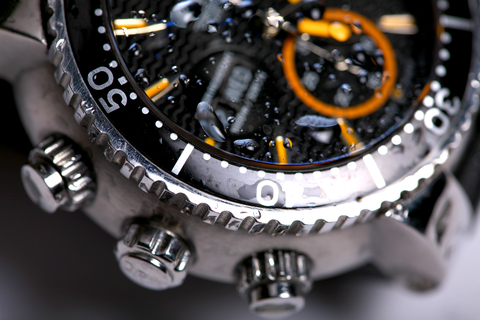
Swiss made divers watches are made of high quality stainless steel to withstand the corrosive effect of seawater.
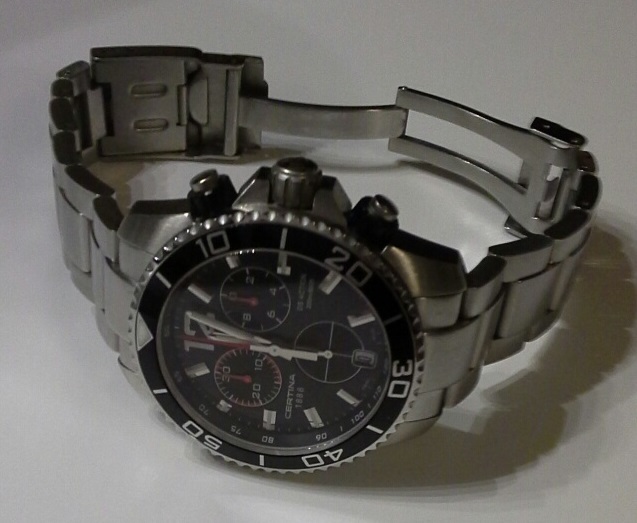
In the picture below you see an example of a clasp of a diver watch.
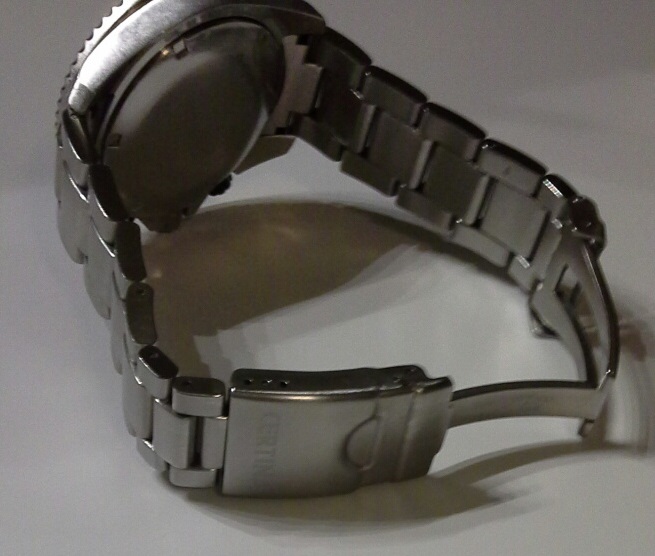
In the picture below you see an example of a diver’s extension which is used to adapt and adjust the size of the bracelet in order to facilitate wearing the diver watch over a diving suit sleeve.
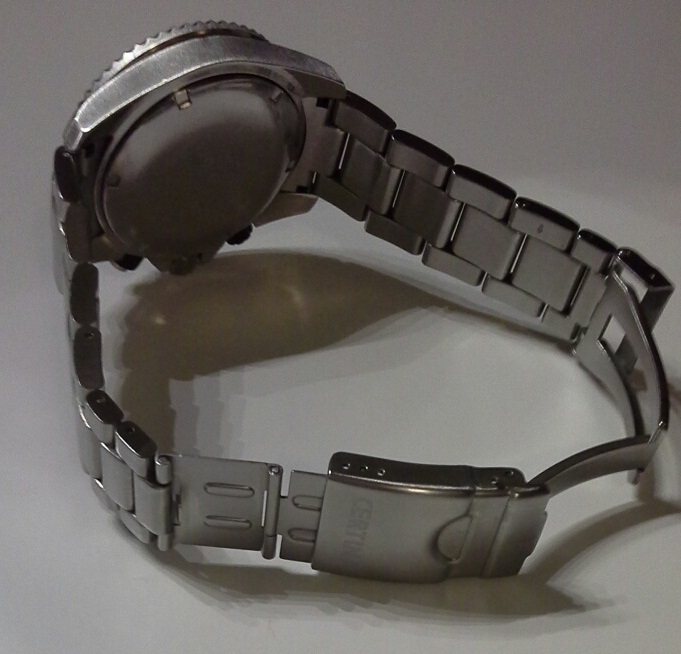
Swiss divers watches need to be equipped with a water resistant crown such as the one displayed in the example below:
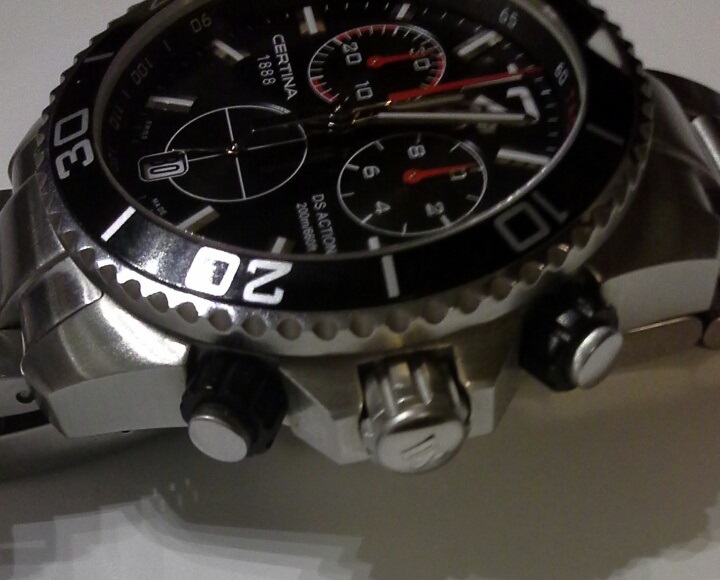
A Swiss made diver watch needs to be equipped with a luminescent dial in order to facilitate reading the time underwater. The dial is of course luminescent outside the water as well.
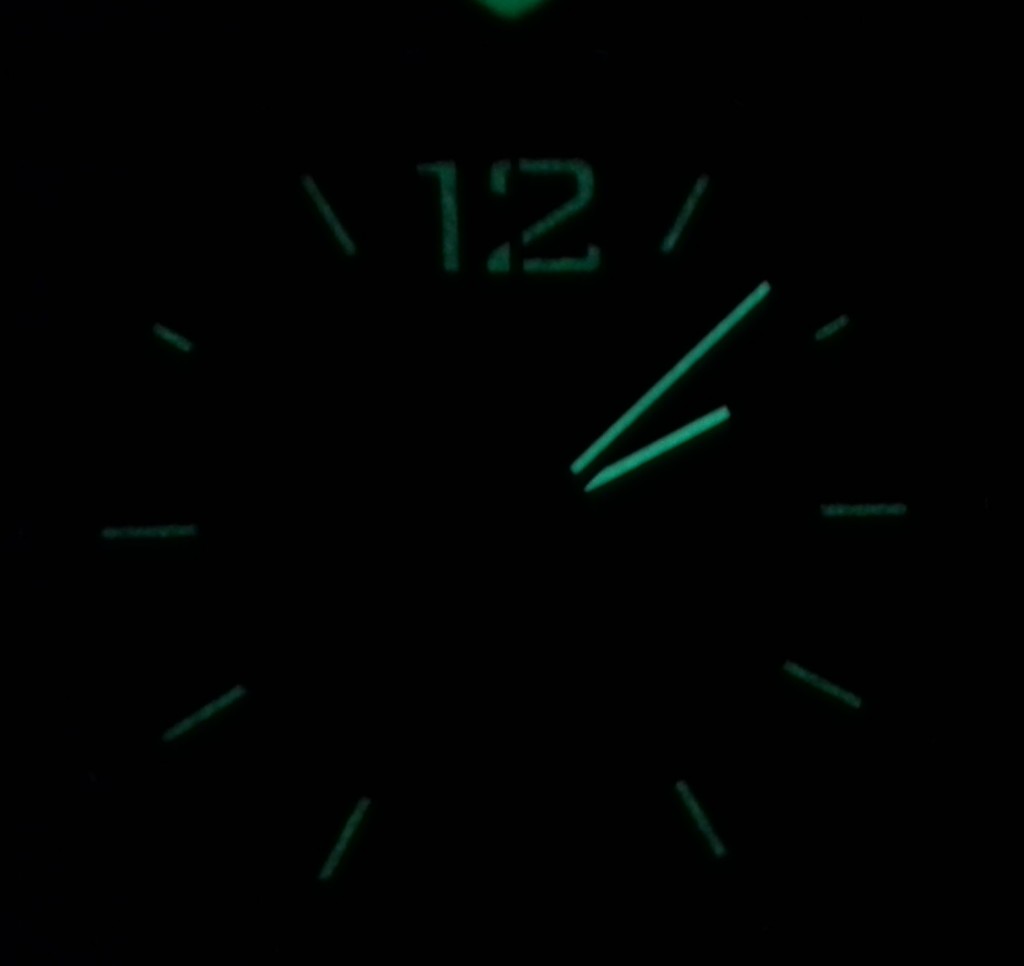
Some Swiss diver watches are water-resistant down to 200 meters:
And others down to 300 meters:
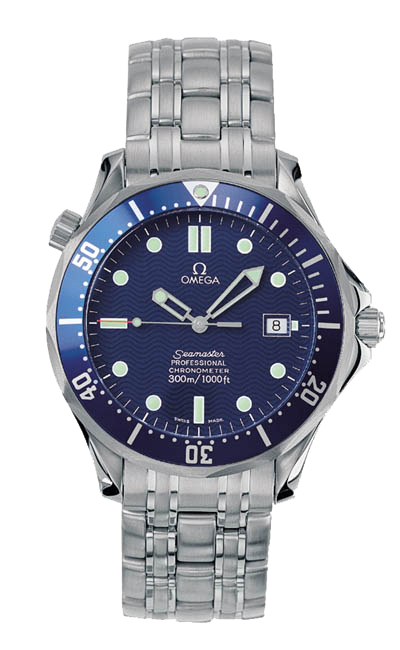
Others down to 600 meters:
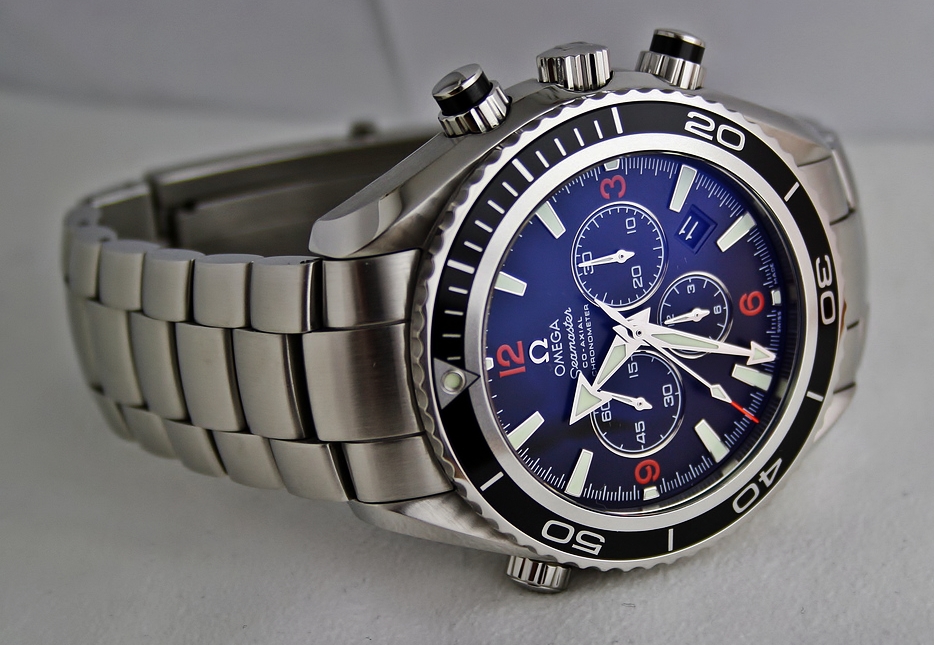
And others down to a staggering 3900 meters:
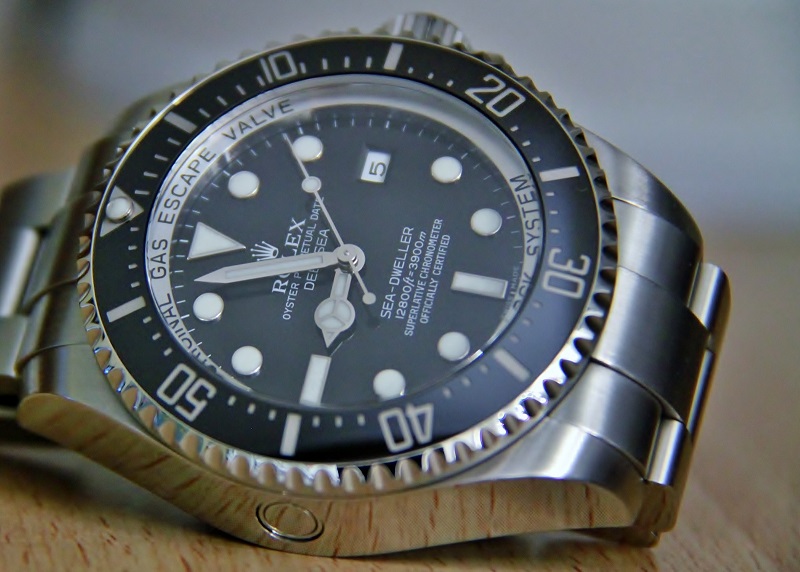
Most divers watches though have a water resistance which is considerably less than 1000 meters. The typical range of water resistance is usually between 200 meters and 500 meters. A water resistance which is less than 200 meters or more than 500 meters is unusual.
There are, of course, dress and sports watches with a minimum water resistance of 330 feet or 100 meters, and yes, indeed, you will find them on this website as well, but technically speaking, they aren’t full-fledged diving watches. Dress and sports watches with 330 feet or 100 meters of water resistance are suitable for swimming and snorkeling but not diving.
Back To The Frequently Asked Questions & Answers Menu
12. What is the ISO-6425 international standard?
“ISO” stands for “International Organization for Standardization“.
The standards for what exactly constitutes a divers watch is regulated and defined by ISO-6425 – this is the international standard for divers watches.
In order for a watch to be qualified to be called a diver watch, the watch needs to be water resistant at 330 feet/100 meters minimum, and must be equipped with a timer in order to measure for how long the diver has been under water.
According to the ISO-6425 international standard, divers watches are tested under 125% of the formally and officially rated water pressure. This means that if a diver watch has a 200 meter rating, it has to withstand a water pressure of 250 meters, and if a diver watch has a 300 meter rating, it has to withstand a water pressure of 375 meters.
Only watches that are officially, formally, and technically ISO-6425 certified are considered to be full-fledged diver watches.
Back To The Frequently Asked Questions & Answers Menu
13. What do the various water resistance levels actually mean?
The water resistance of a diver watch is measured in, and based on, the watch being in a strictly stationary position, and not when the watch is in motion.
For example: if a diver watch is water resistant down to 300 meters/1000 feet, it means that the water resistance of the watch has been tested in a stationary position. When you’re diving and the watch is in motion, the water resistance of the watch is considerably less than the water resistance indicated on the dial.
The fact that a watch’s water resistance level is measured in meters, feet, or ATM (atmospheres) can indeed be confusing.
Many people might believe that a watch that is 30 meters water-resistant (which is well below the minimum requirement for a diver watch!) can withstand diving to a depth of 30 meters. This, however, is incorrect.
Below I will clarify what applies to the different levels of water resistance:
- < 30 meters/98 feet: The watch shouldn’t be exposed to water at all.
- 30-50 meters/98 feet-164 feet: The watch can withstand splashes of water.
- 100 meters/330 feet: You can go showering, bathing, and swimming with the watch.
- < 200 meters/656 feet: You can go snorkeling, and diving with the watch.
While the watch is underwater: Regardless of the water protection, you should never unscrew or open the crown of the watch, or push any buttons, because the water will penetrate the pressure protected casing, and the water will seep into the watch.
Back To The Frequently Asked Questions & Answers Menu
14. What is a “unidirectional bezel”?
This denomination is commonly used concerning divers watches. A diver watch has typically a “bezel” – a ring shaped object that surrounds the sapphire crystal. We can call it the “frame” that surrounds the dial. You can turn or rotate the bezel in a counterclockwise direction. On most divers watches, you can only turn the bezel in one direction. That’s why it’s called “unidirectional bezel”.
In the picture below, you see an example of a bezel. The purpose of using the bezel is to determine at what exact moment you have dived into the water and exactly how many minutes you’ve been underwater. The reason why most divers watches use a unidirectional bezel is because the diver might accidentally nudge the watch and the bezel underwater, and that might change the position of the bezel. Instead of believing that you have more time of oxygen underwater than you actually have, it’s better to believe that you have less time, and therefore you will head quicker for the surface. The unidirectional bezel is meant to protect the diver’s life.
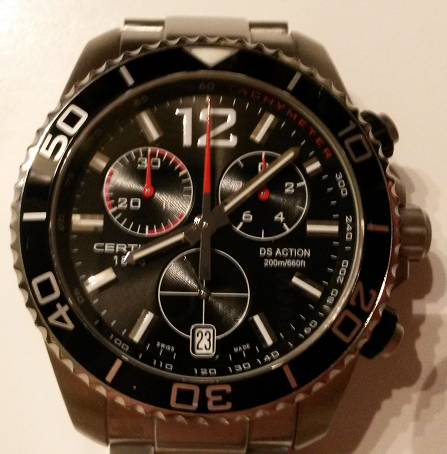
In the image below you see another example of a Swiss diver watch equipped with a unidirectional bezel:
Back To The Frequently Asked Questions & Answers Menu
15. How does the bezel work?
Take a look at your watch. What time is it? Where’s the minute hand at this moment? Turn the bezel in the counterclockwise direction until the main marker or “zero” points at the minute hand. This represents the time you dived into the water. By reading the marker or the “zero” you can determine for how long you’ve been underwater. In the picture below, the unidirectional bezel has been turned in an anti-clockwise direction, where the white arrow marker on the right is aligned with the minute hand and marks the moment the diver entered the water – in this case 8:15.

Back To The Frequently Asked Questions & Answers Menu
16. What are quartz, automatic and mechanical movements?
The lion’s share of most timepieces that are manufactured and sold around the world can be divided into three categories: quartz, automatic and mechanical watches.
A quartz watch/quartz movement:
A “quartz watch” or “quartz movement” is the same as a battery driven watch. It is estimated that roughly 80% of the timepieces that are manufactured and sold around the world are quartz.
Among these three watch movements, quartz is the most modern one, the most affordable and the most accurate. Many Swiss made watches are quartz/battery driven. You don’t need to do anything to keep the watch working. As long as the battery works, the watch takes care of itself.
An automatic watch/automatic movement:
An automatic movement is a mechanical movement powered by your hand and arm movements. An automatic movement doesn’t take batteries.
You don’t need to wind up the watch manually every day. You can easily wear an automatic watch 24/7, 365 days a year without ever having to wind it up.
How does an automatic movement work? The movement is equipped with a metal rotor – usually shaped as a half-circle. The rotor is activated by your hand and arm movements, and thus the rotor moves and spins in a circular motion, and automatically winds up the mechanical movement and keeps the watch movement going. That’s exactly why you don’t need to manually wind up an automatic watch every day.
You need to wind up your automatic watch manually the very first time you intend to use it or whenever it stops. It stops when you put away your watch for several days and the movement isn’t wound up any longer by your hand and arm movements.
The power reserve of an automatic movement means for how many hours the watch can keep going without you having to wear it and wind it automatically with your hand and arm movements. The power reserve varies depending on the brand and the model, but power reserves of 30-70 hours are quite common.
A mechanical hand wind watch/movement:
A mechanical watch is old school technology – the oldest of the three. Mechanical movements use the oldest technology in the context of horology, and mechanical watches just like automatic watches, take no batteries. It’s the kind of watch that your grandfather or grandmother used to wear. You activate a mechanical watch by manually winding it up. You need to wind up a mechanical watch every day or every few days – depending on the model – to keep the movement going. Some watches have power reserves for a few days. It doesn’t matter if you wear the watch or not – if you don’t wind the watch, sooner or later the mechanical watch will stop.
The power reserve of a mechanical movement means how many hours or days of power is left or stored inside the movement before you need to manually wind up the watch again.
Back To The Frequently Asked Questions & Answers Menu
17. What do automatic and mechanical movements look like?
Below is an example of an automatic movement. An automatic movement is powered by your hand and arm movements. As long as you use an automatic watch on a daily basis – you don’t need to wind up the watch, since your hand and arm movements automatically wind up the watch – hence the name – “automatic movement”. You can clearly see the semicircular metal rotor which winds the mainspring. This is the rotor that moves due to your hand and arm movements.
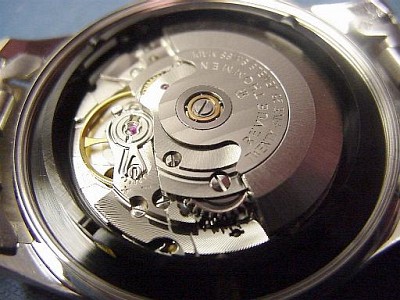
And below you see an old fashioned mechanical movement – you need to wind up this kind of movement every day or almost every day – even if you use your watch 24/7 365 days a year. As you can see, there is no semicircular rotor inside the movement. That is the main difference between an automatic and a mechanical movement.
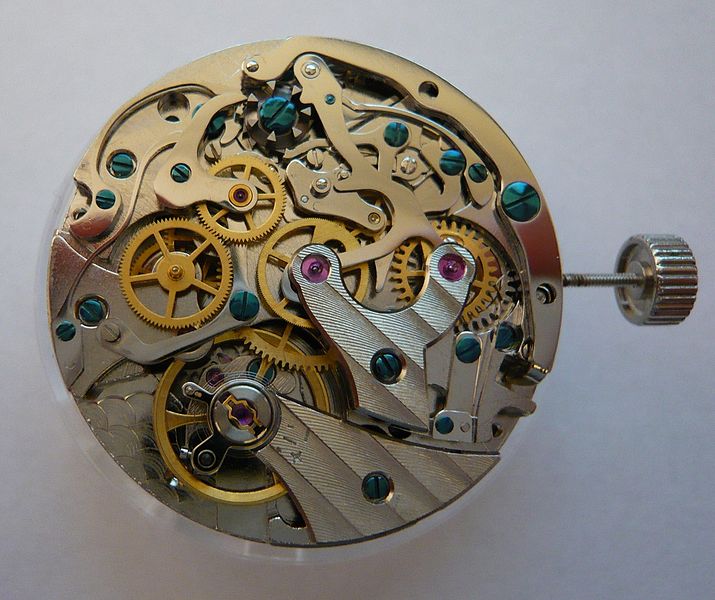
Back To The Frequently Asked Questions & Answers Menu
18. What is the history of quartz, automatic and mechanical movements?
Quartz/battery driven watches: Quartz or battery driven watches were first produced and manufactured in the late 1960s and early 1970s. Prior to that point of time, timepieces were either mechanical or automatic.
Automatic watches/movements: Swiss watchmaker Abraham-Louis Perrelet invented the automatic watch in 1770. He invented the self-winding mechanism for pocket watches. Back then wrist watches didn’t exist yet. The first person to use and apply the principles of the automatic movement in wrist watches was John Harwood. Rolex improved Harwood’s design in the 1930s, and took a giant leap towards the ubiquitous and universal usage of automatic watch movements. By the 1960s, automatic watches or movements were manufactured and sold by many watch brands – among them Tissot and Omega.
Mechanical watches: The oldest technology of the three. In 1275, mechanical clocks were invented in England. In 1541 the Swiss watch industry was born. By 1574, the first pocket watch, or pocket sized watch was invented. In 1680, the very first minute hands were invented and added to clocks. In 1690, the second hand was invented and added to clocks. By 1700, the ownership and usage of clocks in all sizes became widespread. In 1715, the deadbeat escapement – a new escapement technology that offers greater precision, was invented by the Englishman George Graham.
In 1770, Abraham-Louis Perrelet invented the automatic watch or self winding mechanism. By 1795, Abraham-Louis Breguet invented the tourbillon escapement. In 1812, Breguet created and invented the very first wrist watch. He created the watch for Caroline Murat, the Queen of Naples.
By 1820, the keyless clock was invented, which means keys are no longer needed to wind or set the clock. In 1822, Nicolas Rieussec invented the chronograph. In 1830, Breguet invented a button for setting the time. This is now more similar to our modern watches. By the time WW1 ended, wrist watches became the preferable way of keeping time.
Back To The Frequently Asked Questions & Answers Menu
19. What maintenance does my watch need?
The recommendations down below come from the Federation of the Swiss Watch Industry FH:
- Quartz/battery driven watches: When the battery has been completely drained, it needs to be replaced, and that’s also a good opportunity to let the watch undergo a routine maintenance. Apart from changing the battery, the quartz watch needs no more maintenance. It’s therefore the easiest watch to use and maintain. Batteries in brand new quartz movements should normally last 4 years and batteries in old and worn out quartz movements, will drain more power and will normally last 1-2 years.
- Automatic and mechanical watches: Despite the differences between automatic and mechanical watches, their movements are all together mechanical, and take no batteries. It’s recommended that automatic and mechanical watches should be serviced and cleaned every three years to guarantee the accuracy of the movement and therefore accurate time keeping. In the picture below you see an example of a mechanical movement.
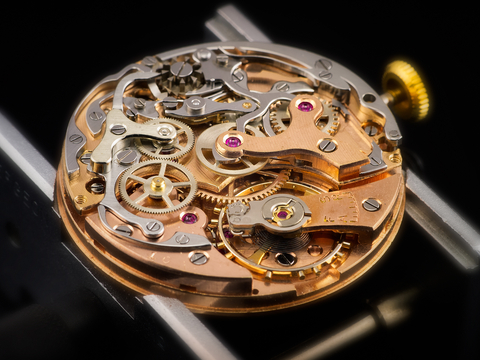
Back To The Frequently Asked Questions & Answers Menu
20. What is the difference between a chronograph and a chronometer?
- A chronograph watch is a stopwatch that’s equipped with an independent sweep second hand. Chronographs usually measure minutes, seconds, and tenths of a second. Chronographs are used for timing events.
- A chronometer watch is essentially a high-precision watch with a movement that is deemed to be accurate enough to receive an official timing certificate from an organization called “Contrôle Officiel Suisse des Chronomètres” – the “Official Swiss Chronometer Testing Institute” (COSC).
It’s entirely possible for a chronograph not to be a chronometer. Conversely it’s entirely possible for a watch to be a chronometer without having any chronograph function.
The timepiece below is Certina DS Action Quartz. It’s a chronograph since it can time events. It can time minutes, seconds and tenths of a second. However this is not a COSC certified watch. On the other hand – it doesn’t need to be, since it’s a quartz/battery movement, and quartz is more accurate than automatic and mechanical movements.
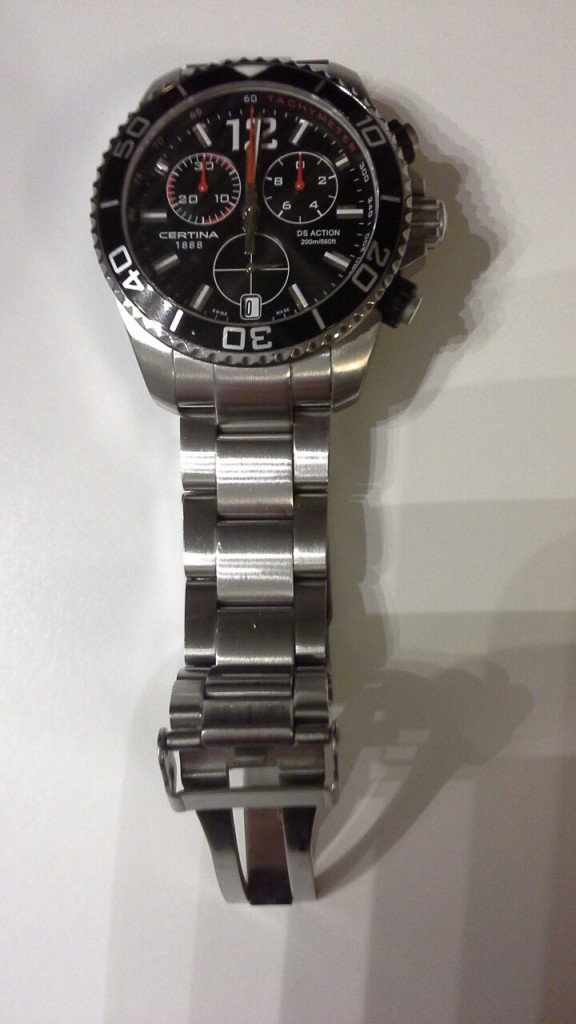
Below you see an example of an Omega Seamaster Planet Ocean Chronograph – which is both a chronometer and a chronograph. You can clearly see the word “Chronometer” on the blue dial.

And in the image below you see an example of a Breitling Avenger Seawolf, which is a chronometer, but isn’t equipped with a chronograph. You can clearly see in French, the denomination “Chronometre Officiellement Certifie” – which means “Officially Chronometer Certified”:
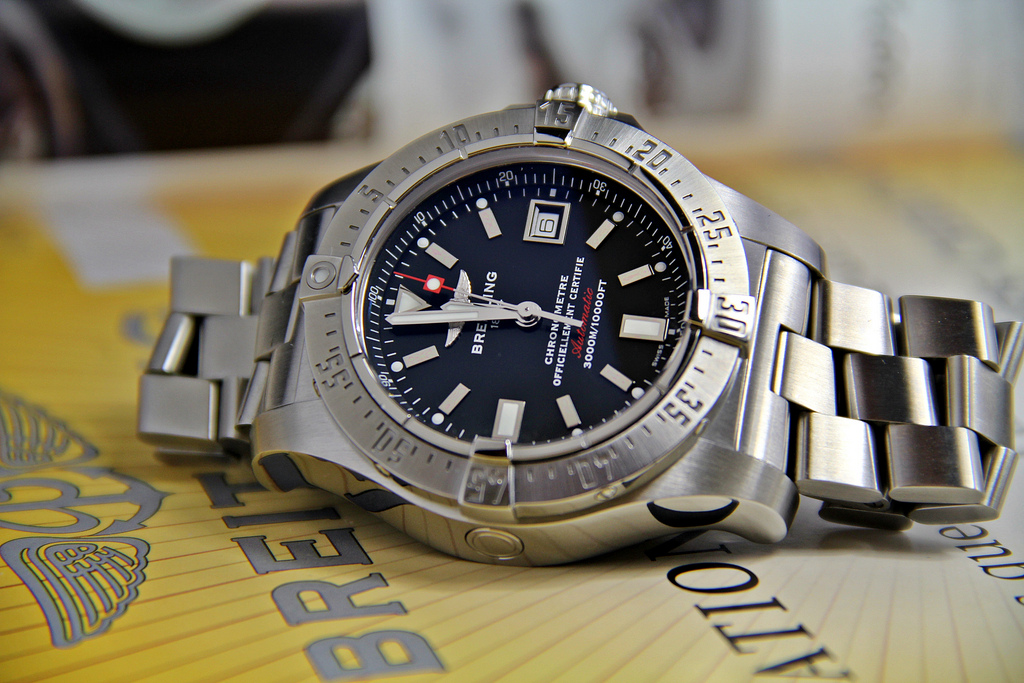
Back To The Frequently Asked Questions & Answers Menu
21. Are all Swiss Made watches chronometers?
No, not all of them. In fact, most Swiss brands aren’t chronometer certified, and this would include most high end, and low end Swiss luxury brands.
Examples of Swiss watch makers that usually have COSC certified watches: Rolex, Omega and Breitling.
Examples of Swiss watch makers that usually haven’t any COSC certificate: Tissot, Certina, Victorinox, Longines, TAG Heuer, Bell & Ross, Oris, Panerai and Jaeger LeCoultre (Jaeger LeCoultre have their own tests!) just to mention a few examples.
While it’s true that the chronometer certificate title (COSC) can almost exclusively be found among high end luxury watch brands, all high end luxury brands aren’t chronometer certified – and yet they are still excellent and highly accurate.
The accuracy standard set by COSC is -4/+6, which means a timepiece can lose 4 seconds or gain 6 seconds a day. However this standard was set decades ago, and modern mechanical and automatic watches exceed by far this outdated accuracy standard.
Even several Swiss brands with mechanical and automatic watch models that aren’t COSC certified, can exceed this outdated accuracy standard.
Mechanical or automatic movements of high end luxury timepieces, are usually more accurate than their more affordable counterparts or less prestigious brands that are using mechanical or automatic movements, and the higher accuracy is due to better made components and high quality parts that constitute the movement. The accuracy is dependent on the technology of the movement – irrespective of the chronometer certificate title.
So let’s clarify the following: it’s the technology and the mechanics of the movement that determines the accuracy of the watch, and not the COSC certificate – which is optional. It’s true that the technology of the movement needs to be accurate enough to fall within COSC accuracy standards, but the COSC accuracy test is 100% optional – no watch maker is required to take the test.
Timepieces or brands that lack a COSC certificate haven’t failed the tests – they simply never took this optional extra test. If you adjust properly your Swiss made non-COSC timepiece, it will very likely perform within the ratings of COSC.
You should simply view the COSC test as a receipt or a confirmation that your watch has been tested for accuracy and passed the test. The COSC test simply means that the timepiece was accurate enough at that particular point of time, in order to pass the COSC test. It doesn’t mean that the movement of a COSC watch will be as accurate within say 5 or 10 years from now as it is today, and it doesn’t mean that a COSC certified watch is necessarily more accurate than a non-certified watch.
Since automatic and mechanical movements consist of springs, gears and tiny metal components that touch each other, friction is being created inside the movement and its constituent parts, and wear and tear over the years will of course be inevitable. That’s why the COSC certificate becomes less and less relevant for each year that passes – simply due to the wear and tear.
The pictures below demonstrate what the beating heart of a timepiece looks like:
Automatic movement:

Mechanical movement:

Due to the daily and yearly wear and tear, it’s recommended that automatic and mechanical watches need to be serviced every 3 years. Timepieces in this sense are similar to tools or cars – timepieces can be worn out too.
The actual day-to day performance of an automatic, and mechanical watch can change a lot during the years, with or without a COSC certificate. Several factors can determine how accurate your automatic and mechanical timepiece will be: wear and tear, how well the timepiece is wound, if it takes a significant bump over the years, in what position you leave the watch in your dresser during the night etc.
So why is the COSC test relevant if it’s not necessarily guaranteed that a certified watch is more accurate than a non-certifed watch? The COSC certificate is meant more as a tool of marketing and sales to emphasize the Swiss watch maker’s excellence. The impression doesn’t have to be wrong – they just want you to notice their brand!
For example: all Breitling watches are COSC certified, yet Breitling Superocean uses a movement called ETA 2824-2. You can find the exact same movement in several Tissot and Certina watches. This movement – ETA 2824-2, is for example the beating heart of Certina DS Action Automatic , which is considered to be a less prestigious brand and no doubt more affordable than Breitling.
What is interesting is that Breitling Superocean uses ETA 2824-2, and is COSC certified, yet Certina DS Action Automatic, which uses the exact same movement – ETA 2824-2, isn’t COSC certified.
The bottomline is this: you shouldn’t pay too much attention to whether or not a watch is COSC certified. For ordinary daily use, it matters very little.
Back To The Frequently Asked Questions & Answers Menu
22. Does the “chronometer” denomination apply to quartz watches as well?
Usually the “chronometer” denomination is almost exclusively used in reference to automatic and mechanical movements.
However, to my knowledge, COSC (Official Swiss Chronometer Testing Institute) has indeed developed chronometer testing methods for quartz/battery driven watches as well, but it’s very unusual that quartz watches are chronometer certified.
I know for a fact that there is a particular Breitling timepiece, or model, called Breitling Colt, and this model is indeed a chronometer certified quartz movement, which means the quartz is unusually accurate – even by quartz standards. In fact, quartz/battery driven watches are more accurate than automatic and mechanical watches. Cheap quartz watches can easily exceed the requirements set by COSC.
If accuracy is your nr 1 reason for purchasing a watch, you should go with quartz. If you on the other hand want to opt for an automatic or mechanical movement, and still want accuracy, you should either go with chronometer certified movements or find a Swiss brand/manufacturer that tests their own watches for accuracy. But as far as accuracy is concerned, quartz is the safest bet.
Back To The Frequently Asked Questions & Answers Menu
23. What is the difference between “Chronometer”, “Certified Chronometer”, “Chronometer Certified” and “Superlative Chronometer”?
On a purely technical and mechanical level, there is no difference at all.
All the different expressions, terms and phrases listed above refer to the one and exact same thing: these are timepieces that have passed the exact same accuracy test – the chronometer test, taken at the exact same institute – COSC – “Contrôle Officiel Suisse des Chronomètres” – the “Official Swiss Chronometer Testing Institute”.
There are no grades or rankings. Either a timepiece is a chronometer or it’s not. There is no such thing such as a “superior”, “inferior” and “intermediate” chronometer. They’re all chronometers. The phrase “Superlative Chronometer”, which to my knowledge, is being used specifically and solely on the dials of Rolex timepieces, is simply meant as a way of communicating with the customer – it’s a way of emphasizing that the Rolex timepiece is indeed a chronometer – and they want you to notice it.
Ultimately, what it really boils down to, is a question of marketing, and sales, and communicating with the customer, and appealing to the customer’s sense of, and desire for quality, and luxury. It’s about distinguishing one luxury brand from another – meaning brand recognition. In the picture below you see an Omega which is chronometer certified. Here it says “Chronometer”:

In the picture below you see a Breitling Avenger Seawolf, where it says in French “Chronometre Officiellement Certifie”:

And down below you see the last picture on this particular topic. Here you see the legendary Rolex Sea-Dweller Deepsea – one of the most recognized and coveted luxury timepieces in the world. On the dial it says “Superlative Chronometer” – a designation, as far as I know, unique for Rolex timepieces:

Back To The Frequently Asked Questions & Answers Menu
24. Just how accurate are mechanical, automatic and quartz movements?
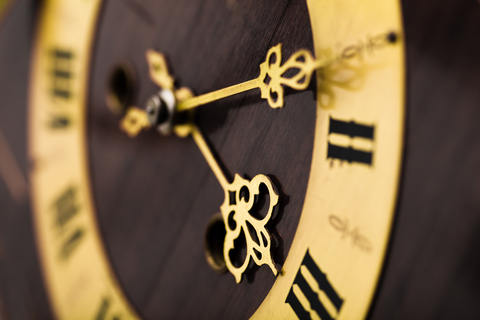
This is a quite interesting question, since many of the online horological discussions regarding what particular kind of timepieces are desirable or not, often involve the accuracy game.
We can divide the watches into three categories: 1) non-certified modern mechanical/automatic watches, 2) chronometer-certified modern mechanical/automatic watches, and 3) modern quartz watches. The accuracy of the movements is determined by dividing the average gain or loss of seconds per day, with the total amount of seconds per day. A day has 86,400 seconds. Typically, the time keeping accuracy for these three categories looks like this:
- Non-certified modern mechanical/automatic watches: Typically, they either lose or gain 5 seconds (+/-5) a day, which sets their accuracy at 99.9942% per day. The worst performance is +/- 10 seconds, and the best performance is +/-2 seconds a day.
- Chronometer-certified modern mechanical/automatic watches: Typically, they either lose or gain 3 seconds (+/-3) a day, which sets their accuracy at 99.9977% per day. The worst performance is +6/-4 seconds, and the best performance is +/-1 second a day.
- Modern quartz watches: Typically they either lose or gain 1 second (+/-1) a day, which sets their accuracy at 99,9998% per day. The worst performance is +/-2 seconds, and the best performance is +/-0.1 second a day.
As you can see, for ordinary daily use, it matters very little, whether you have a quartz/battery watch, or a COSC certified mechanical/automatic watch, or a non-certified mechanical/automatic watch. The accuracy involves just a few seconds a day. Even non-certified mechanical/automatic watches are more than enough for ordinary daily use.
When people passionately talk on Internet forums about the accuracy of particular commercial timepieces, it’s simply a matter of their personal satisfaction and preference – it’s not an objective requirement or objective standard which you need to pay any attention to – unless this matters to you personally. Unless your career, job or daily work routines require an extremely accurate timepiece that needs to get every second right, I wouldn’t be worried at all about the accuracy of the timepiece.

Back To The Frequently Asked Questions & Answers Menu
25. What is a tachymeter?
A tachymeter is a feature that can be found in chronographs – that is stopwatches – not to be confused with chronometers. Only chronographs/stopwatches are equipped with a tachymeter function. A tachymeter is the track of numbers that you can usually find either on the dial or on the bezel. Most tachymeters start at 400 and end at 60.
A tachymeter scale is usually used to calculate the speed of an object travelling at a fixed distance. You can use a tachymeter at racing events or when you want to calculate the speed of a car in an ordinary everyday situation.
The tachymeter scale can be used to measure both miles and kilometers. Any unit of measure can be used. For example, if a car travels 1 mile at 15 seconds, it equals 240 miles per hour. If a car travels 1 kilometer at 15 seconds, it equals 240 kilometers per hour. If a car travels 1 mile at 45 seconds, it equals to 80 miles per hour. If a car travels 1 kilometer at 45 seconds, it equals to 80 kilometers per hour. Down below you see an example of a tachymeter:

⇒You activate the tachymeter by pushing the top right button shown in the top right corner of the picture above. This activates – in this case – the large red second hand, and when you wish to stop timing, you push the same button in the top right corner, and the second hand stops.
⇒If you want to reset the second hand and the timing, push the lower right button, and the large red second hand returns to its “zero” position in the picture above.
⇒Let’s use an example: You want to time the speed of a car. You push the top right button to start timing the car when it starts, Let’s say that the car covers 1km/mile in just 12 seconds – and you stop timing at 12 seconds. The tachymeter shows “300”. What does it mean? It means in 12 seconds the car has covered 1 km/mile, in 60 seconds (one minute) the car has covered 5 km/miles, and in 60 minutes the car has covered 300 km/miles per hour. If you stop timing the car at “300” , it means its speed is 300 km/miles per hour.
In the particular tachymeter above, you see that the scale starts at 300 and ends at 60. “Tachymeter” is marked clearly in red letters. It is the large second hand – in this case – the red colored second hand, that is being used for the tachymeter function. The large second hand can of course be used for other chronograph functions as well. The current position of the bezel (used for diving) in this picture has of course no relevance to the tachymeter function. It doesn’t matter in which position the bezel is in – the tachymeter on this particular watch, is to be found on the dial of the watch.
Back To The Frequently Asked Questions & Answers Menu
26. What is sapphire crystal glass?
Sapphire crystal glass is the preferred glass material of luxury watches – particularly Swiss Luxury Watches. Almost all Swiss Luxury Watches with very few exceptions – Swiss Divers Watches included – are equipped with sapphire crystal glass. Sapphire crystal glass is the hardest oxide crystal.
Sapphire – whether natural or synthetic, is one of the hardest substances on earth. There is a scale measuring hardness of substances, called “Mohs scale”. On Mohs scale, sapphire measures 9 out of 10. Diamond – the hardest substance on earth – measures 10 out of 10. Sapphire crystal glass possesses several desirable features such as wearability, high strength, high level of hardness, corrosion resistance, high heat-resistance, and light transmittance performance.
Most non-Swiss brands are equipped with mineral glass, which does not even remotely measure up to sapphire crystal glass. The fact that you’ve opted for a Swiss Luxury Watch, means by default, that your watch will be equipped with sapphire crystal glass. The most affordable Swiss Luxury Watches, may be found in a price range between $300-$700, and yes – they too are equipped with sapphire crystal glass! Down below is an example of a Swiss Luxury Watch/Swiss Divers Watch, equipped with sapphire crystal glass:
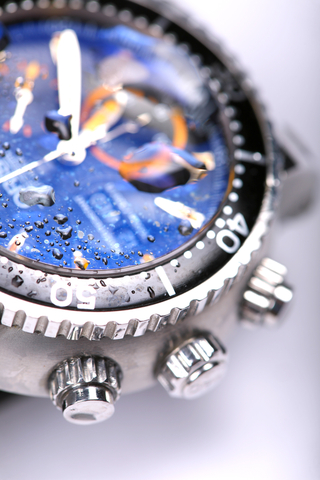
In the comfort of your own home, you can actually perform a rather simple test to ascertain whether or not your watch is equipped with a sapphire crystal glass.
You see, water interacts in a certain way with sapphire crystal glass. Keep the timepiece still and place it on a flat surface such as a table. Simply dip your finger in water and drop a dribble on the sapphire crystal glass. The drops should look like the ones below. They are compact well defined drops of water. This indicates that the glass in the picture is indeed sapphire. If you would perform the same simple experiment on mineral glass, the water would simply spread all over the dial.
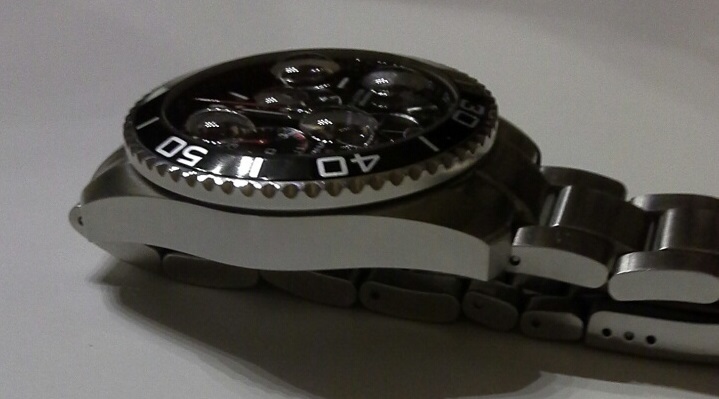
Back To The Frequently Asked Questions & Answers Menu
27. What do “T Swiss Made T”, “Swiss T 25”, and “L Swiss Made L” mean?
At a particular depth, the water is dark. That’s why you need to be able to read divers watches in the dark. In order to read them in the dark they need to be equipped with a luminescent material. That luminescent material can be found on the hands and the indexes of the dial. The emission of light is usually either of the photoluminescent type or of the radioluminescent type. Photoluminescence is determined by exciting luminous radiation. Radioluminescence is determined by the material’s radioactivity. Usually professional divers watches or military watches use radioluminescent emission. The radionucleides tritium and promethium radiate low energy.
“T Swiss Made T” means: it’s a Swiss watch with a deposit that is activated by tritium.
“Swiss T 25” means: it’s a Swiss watch with a deposit activated by tritium that emits less than 25 mCi (millicurie).
“L Swiss Made L” means: Swiss watches that use a light photoluminescent type. In fact, the lion’s share of Swiss watches use a light photoluminescent type. They don’t have to bear the marking “L Swiss Made L” – the marking is optional. For example Panerai timepieces are known to use the “L Swiss Made L” denomination on their dials.
Most Swiss timepieces however bear the denomination “Swiss Made” without any prefix or suffix.
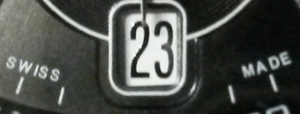
Back To The Frequently Asked Questions & Answers Menu
28. What does a luminescent dial look like?
In the picture below you see an example of a luminescent dial in a Swiss Divers Watch – in this case Certina DS Action Quartz:

Luminescent dials such as the example above, are relevant for reading the dial in the dark- particularly underwater. All divers watches must be equipped with a luminescent dial.
Back To The Frequently Asked Questions & Answers Menu
29. Can I clean or wash my timepiece in the comfort of my own home?
Yes you can clean your timepiece in the comfort of your own home, on condition that your watch’s water resistance is a minimum of 100 meters/330 feet. You can simply use ordinary lukewarm running water and lather skum. You can also use a toothbrush, and washing-up liquid for cleaning, and washing your timepiece.
You can easily clean the case and the metal bracelet/rubber strap in less than a minute. You can use an ordinary paper towel or a towel for drying off the watch.
Make sure to avoid hot water since hot water can ruin the mechanical and automatic movement inside the watch on a long term basis. You should either use slightly cold running water or lukewarm running water for cleaning your watch.
Just keep in mind that:
- if you opted for a leather strap instead for a rubber strap or a metal bracelet, you will need to take off the leather strap before you clean or wash the case; otherwise you’ll ruin the leather;
- please make sure that the crown/main button of the watch is properly screwed down and sealed. Once the crown is sealed you don’t have to worry about the water resistance of the diver watch. When the crown is sealed, you can go diving with the timepiece, and you clean it at home. If you necessarily need to unseal the crown, in order to rewind an automatic watch, or setting or adjusting the time of an automatic watch or quartz watch, do so only when the watch is perfectly dry. In the picture below you see an example of a watch with a sealed crown. The crown is the button in the middle. The two other buttons are used for the chronograph function:
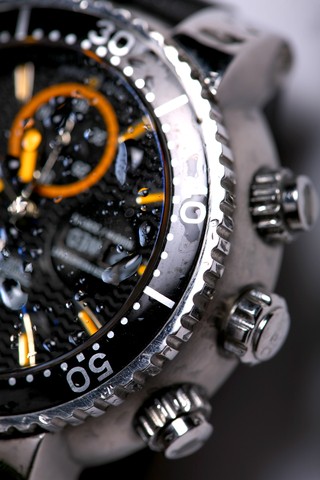
Back To The Frequently Asked Questions & Answers Menu
30. Why are some watches more expensive than others?
There are four fundamental reasons for that, although it’s quite possible that there are even more reasons.
1. Expensive and precious materials that have been used, such as gold, platinum, jewels and diamonds.
But to be perfectly honest with you, most Swiss Luxury Watches use stainless steel – and yet they are very costly. So the fact that some particular models happen to use precious materials doesn’t entirely explain why these watches are so expensive.
However the usage of precious materials does explain, at least partially, why many Swiss Luxury Watches are so costly. Timepiece models within the same brand that use precious metals and materials are absolutely more costly than those using stainless steel. However, the high cost is attributable to more than just precious materials, and as it has been stated earlier – most Swiss Luxury Watches are actually made of stainless steel.
2. Higher production and labor costs – the time it takes to manufacture the timepiece is factored into the price.
Regarding “usual” or “common” watches: It takes usually a few days or weeks at the most, to manufacture mass produced “ordinary watches” – usually equipped with quartz/battery movements. It doesn’t take master watchmakers to assemble or manufacture battery/quartz powered movements, since these are relatively easy to manufacture and assemble in a very short period of time.
A “typical” and “ordinary” battery/quartz watch, meant for mass consumption, will most likely take 1-2 weeks to manufacture. Long term planning, inventions, finest quality materials and master watchmakers aren’t needed for manufacturing these watches.
Things are very different with regards to Swiss luxury watches! It can take a few months – say 3-4 months to manufacture Swiss luxury watches. Manufacturing even more expensive models and watches can take as much as 6 up to 9 months, and sometimes even a full year, and sometimes even more than that. The long manufacturing time implies higher production costs and higher labor costs.
A considerable amount of planning is needed, and so are inventions, tests, prototypes and advanced manufacturing stages. Furthermore, the individual watchmakers’ dexterity and skills, quality tests and so on, are needed in order to manufacture and assemble true Swiss luxury watches!
Master watchmakers, engineers, designers and craftsmen invent, conceive, test, design, produce, manufacture, decorate and craft every single conceivable part of the movements, cases and bracelets into a work of technical and aesthetical art – and the whole process can literally take months. Usually, only the finest high quality materials are being used. That’s why Audemars Piguet, Patek Philippe, Breguet, Blancpain, Jaeger LeCoultre, Rolex, Tudor, Omega, Breitling, and IWC, just to mention a few prominent examples, charge premium prices.
The most prestigious and expensive watches on the market – are Audemars Piguet, Vacheron Constantin and Patek Philippe (all three are Swiss brands – they form “The Holy Trinity”) can take as much as 9 months, and even a full year, and sometimes even more than a full year, to manufacture. The most basic Patek Philippe timepieces for example, take 9 months to manufacture by hand. I promise – it’s not a joke!
3. The warranty service is factored into the premium price.
Since automatic and mechanical watches, unlike quartz, consist of old fashioned technology, there are more things that can go wrong, and therefore the automatic and mechanical watches are more likely to incur an in-warranty service. The cost of the in-warranty service is thusly factored into the price of a premium watch.
4. Smaller quantities are produced.
Since more time and effort are invested in inventing and conceiving (yes, Swiss luxury watches start out as concepts and prototypes), manufacturing, designing, decorating and crafting every conceivable detail of the movement and the case of the high end luxury timepieces, it means they are produced and manufactured in considerably smaller quantities, and in order for the watch manufacturers to generate revenues in their industry, they need to charge considerably higher prices per manufactured unit.
Since most high end luxury watches are either automatic or mechanical, and since automatic and mechanical watches are sold in considerably smaller numbers than the considerably more numerous and affordable quartz/battery driven watches, it means there is a slower return on their investments. That’s why they need to charge premium prices. That’s why for example Rolex, Omega and Breitling charge higher prices than say Victorinox, Longines and Tissot.
Just to clarify: The intention is not to express any preference of one watch manufacturer over another. The abovementioned watch manufacturers just serve as examples. All of these Swiss brands are excellent and highly prestigious.
Back To The Frequently Asked Questions & Answers Menu
31. Why are some watch cases thicker whereas other cases are thinner?
As far as divers watches are concerned, there are several technical, mechanical and physical reasons for that.
The two main reasons are:
- A chronograph movement is thicker than a non-chronograph movement. A chronograph movement has more functions added to it, is therefore thicker and larger, and therefore needs a thicker case.
- A thicker case is needed to protect the watch at greater depths.
If a watch is supposed to be water resistant at a considerable depth, the watch needs a thick or thicker case in order to protect the movement against the pressure from the water.
For example: Rolex Submariner – quite possibly the most recognized and the most legendary watch on the market, and quite possibly the most legendary watch ever produced, is water resistant at 300 m/1000 ft, and the case is rather thin and compact. The “bigger brother” – the Rolex Sea-Dweller Deepsea, which is water resistant at 3900 m/12800 ft, is considerably thicker than Rolex Submariner, in order to withstand the pressure from the sea at greater depths.
Back To The Frequently Asked Questions & Answers Menu
32. What is a mainspring?
A mainspring is a small metal coil or spiral used in automatic and mechanical movements. When you wind the watch by turning the crown, energy is being stored in the mainspring, and the force or energy stored in the mainspring is what drives or powers the wheels inside the watch movement. When you wind the watch, and thusly twist the spiral tighter, the spiral will “uncoil” due to the pressure being built up, and that’s exactly what powers your automatic or mechanical watch.
Back To The Frequently Asked Questions & Answers Menu
33. What is an escapement?
An escapement is a mechanical device in the movement, which regulates the movement.
An escapement is essentially a cogwheel equipped with a pendulum. The pendulum touches the teeth of the cogwheel and regulates the movement of the cogwheel.
The escapement counts the exact number of oscillations – that’s essentially what it’s built for. This creates an organized, regular, constant and periodic advancement of the watch dial’s hands: the hour-, minute- and second hands. It’s not enough that the movement’s mainspring has got power – the power needs to be transferred and regulated. That’s exactly what the escapement is used for.
There are several kinds of escapements:
- Cross-beat escapement.
- Anchor escapement.
- Verge escapement.
- Pin wheel escapement.
- Detent escapement.
- Deadbeat escapement.
- Duplex escapement.
- Cylinder escapement.
- Gravity escapement.
- Grasshopper escapement.
- Constant escapement.
- Coaxial escapement (used exclusively in Omega watches).
Just a quick note on Omega’s co-axial escapement: The co-axial escapement, designed and invented by British watchmaker George Daniels, reduces the friction inside the movement and thusly increases the durability of the watch movement, which means that the watch needs to be serviced less frequently.
This means that the watch can and will function well during longer time intervals. The co-axial escapement, or co-axial movement, is the star of the show of the modern Omega brand, since Omega nowadays builds a lot of its modern prestige around this technology.
Back To The Frequently Asked Questions & Answers Menu
34. What is a balance wheel?
A balance wheel is powered by the escapement. Power is transferred from the escapement to the balance wheel and thusly produces energy to swing the wheel. Each swing of the wheel is equivalent to one “beat” or “tick”. This is what moves the hour hand, minute hand and second hand forward at a set amount.
Back To The Frequently Asked Questions & Answers Menu
35. What is a hairspring?
A hairspring is a finely made coiled spring which regulates the movement of the balance wheel. Without the hairspring, the balance wheel wouldn’t work. The balance wheel is used to regulate the movement of the watch so that the hour-, minute – and second hands move forward at a precise, set, exact and regulated pace.
It’s easy to confuse the hairspring with the mainspring. The mainspring is the main coiled spring which powers the entire movement. When you manually wind your mechanical or automatic watch, when you turn the crown on the watch case, you are winding the mainspring. It’s the mainspring which winds up the watch. But like I just mentioned: the mainspring and the hairspring are two completely different springs.
Back To The Frequently Asked Questions & Answers Menu
36. What are watch movement jewels?
Watch movement jewels are synthetically manifactured rubies or sapphires that have been polished and drilled. They serve as bearings for the gears in the watch movement, in order to reduce the friction of mechanical parts.
By reducing the friction inside the movement, the movement will last longer.
Since metal components inside the movements are subject to constant friction, a material harder than metal is needed to reduce friction. Synthetic rubies are used because they are harder than metal and rank higher on Mohs scale – a scale measuring the hardness of substances.
A simple mechanical watch – that is a watch that indicates just hours, minutes and seconds – should include a minimum of 15 jewels, in order to reduce friction at those places within the movement that are subject to friction.
Watch movement jewels despite their name, aren’t really precious gems. Understandably, the phrase could cause misunderstanding.
You can clearly see a few visible purple colored synthetic rubies in the mechanical movement below.

Back To The Frequently Asked Questions & Answers Menu
37. What is vph?
Vph stands for vibrations per hour, and is a measurement of the frequency or speed of the watch movement.
A single swing of the balance wheel is equivalent to one vibration. One vibration is equivalent to one half of an oscillation. The oscillation can either be in a clockwise or anti-clockwise direction. Two swings/two vibrations are equivalent to a full oscillation. Hertz (Hz) or vibrations per hour (vph) are the most common measurements of the watch’s frequency.
For example: The most common frequency of modern automatic or mechanical wristwatches is 28,800 vph. When you purchase watches online, the vph of the watch is frequently given in the watch details. 28,800 vph means 28,800 vibrations or swings per hour. Since one hour has 60 minutes and 3600 seconds, it means 28,800 vibrations(swings) / 3600 seconds yields 8 vibrations (swings) per second. It means this is a timepiece which ticks 8 times per each second.
A formula you can use when using Hertz (Hz) looks like this: Number of Hz per second, multiplied by 2, and then multiplied by 3600.
If the timepiece is ticking at 4Hz, it means it makes 4 oscillations per second, which is equal to 8 half-oscillations per second. 8 half-oscillations (or semi-oscillations) multiplied with 3600 seconds (one hour) yields the same result – 28,800 vibrations per hour.
Let’s use the same formula again, but this time regarding a timepiece which is ticking at 2.5Hz. That’s equal to 2.5 oscillations per second, which is equal to 5 semi-oscillations per second, and multiplied by 3600 seconds (one hour) yields 18,000 vibrations per hour. As you can see – a considerably slower watch.
The frequency of the watch – number of ticks per second, also determines the visual appearance of the movement of the second hand of the dial: A jerky movement means fewer ticks per second and a smoother movement means more ticks per second.
Back To The Frequently Asked Questions & Answers Menu
38. What is a power reserve?
A “power reserve” is the x or y amount of hours (or days) during which the automatic/mechanical watch will keep ticking and keep time – without the wearer’s direct interference or interaction with the wristwatch.
The usual power reserve range is somewhere between 30-70 hours for automatic and mechanical watches.
A power reserve well above 40 hours is considered good, and a power reserve around 50 hours – is probably very good, and a power reserve around 60 or 70 hours is excellent.
So let’s explain the whole concept of power reserve for:
- Purely mechanical/hand wound watches,
- and automatic watches.
Mechanical watches are the kind of watches you need to wind up manually everyday or almost everyday:
No matter if you wear them or not – they will stop unless you wind them up manually again. Some of them have a power reserve of 2-3 days (48-72 hours) – some of them a solid week/7 days of power reserve. Some of these mechanical watches have a “power reserve display” on their dials – telling you when you need to manually wind up the watch again before it stops – before the “power reserve” is completely drained.
Most mechanical watches however don’t have a power reserve display on their dials. It’s recommended that you wind them up manually every day or every second day.
Automatic watches are similar but different:
Automatic watches are mechanical – they take no batteries. Just like old-fashioned mechanical watches, you need to manually wind up your automatic watch the very first time you intend to use it – or whenever your automatic watch stops. In this sense, the automatic movement is similar to mechanical watches. No automatic movement is 100% automatic – their basic system is mechanical.
How does an automatic movement differ from an old fashioned mechanical movement? The difference is this: Unlike purely old-fashioned mechanical watches, automatic watches are equipped with a semi-circular metal rotor inside the watch movement/caliber.
When you move your hand or arm, the semi-circular rotor inside the movement, will move, spin or rotate in a circular fashion, and automatically wind up the movement for you.
As long as you use and wear your automatic watch every day or almost every day, it will be as easy and carefree to use it as a battery driven watch. It will take care of itself – you don’t need to wind up the automatic movement manually at all on a daily basis. You can manually wind up the automatic watch for extra power if you wish – but that is by no means any requirement for the automatic movement.
If you don’t use your automatic watch for a couple of days, and you leave it on the dresser, on the bureau or on the desk, the watch and its rotor are no longer powered by your hand and arm movements – the watch starts behaving like an old-fashioned mechanical watch, and the watch movement needs to rely on the power reserve stored inside the movement until the watch eventually stops – and that’s the “power reserve” which is being referred to so frequently.
To conclude: A “power reserve” is an expression only used in the context of automatic/mechanical watches.
Back To The Frequently Asked Questions & Answers Menu
39. What is a power reserve indicator?
It’s an indicator on the the dial which indicates just how many x or y days of power is stored inside the automatic/mechanical movement until it stops.
Mechanical watches need to be manually wound up every few days whereas automatic movements are powered by your hand and arm movements, but will start behaving like old fashioned mechanical watches, and will need to rely on the power stored inside the movement, when you no longer use and wear them, and have placed them on the dresser, the bureau or on the desk – or wherever you keep your watch.
Do all automatic/mechanical watches have a power reserve indicator on their dials? No they don’t – most of them don’t have power reserve indicators.
Back To The Frequently Asked Questions & Answers Menu
40. What is an in-house watch movement?
An in-house movement is a movement which has been manufactured by the watch manufacturer itself.
“Manufactured” doesn’t necessarily mean invented or developed by the watch manufacturer. They can purchase the right to manufacture their own movements without necessarily being the ones who invented the movements.
Yes some watch manufacturers have both invented and manufactured their own watch movements. However the expression “in-house movement” simply means that the watch manufacturer produces the movements on its own, in its own factories, without hiring a third party and without outsourcing the production of the movements and without purchasing the movements from third party movement manufacturers.
Now why is it that so many watch enthusiasts and watch purists prefer in-house made movements over movements that aren’t being made in-house? Because they are under the impression that an in-house movement is “better” or more “exclusive” since the watch manufacturer itself produces the movements and supervises the production of the movements.
However the fact that a watch movement is produced in-house is by no means any guarantee that the watch movement is necessarily “superior” to movements that aren’t in-house made. The expression “in-house made” doesn’t reveal what criteria or standards are used to produce the movements.
In-house made movement means in real terms that the watch brand needs to take upon itself additional production costs.
An in-house made movement can but doesn’t have to be “superior” to movements that aren’t in-house made. The context of the usage of the word “superior” is of course used to describe the technology and the mechanics of the movement. In this case it would refer specifically to the accuracy, the reliability and the quality of the movement.
Is it common that watch manufacturers produce their own movements? No it’s not. It’s a matter of fact it’s quite rare and very unusual. Most Swiss Luxury Watch Brands actually purchase and procure their movements from a third party – Swiss Swatch Group is a prominent example which manufactures and sells ETA-movements to several Swiss Luxury Watch Brands.
However, my honest advice to you is that you shouldn’t use the in-house made concept as a reason for purchasing or not purchasing a specific watch model, belonging to a specific watch brand. All Swiss Luxury Watch Brands are excellent whether they have in-house made movements or not.
You should purchase a watch model with an in-house movement only if this matters to you personally. Only you can decide what’s important to you. In-house movement simply means that the watch manufacturer or brand, produces itself the movements in its own factories. Only you can judge whether this is relevant to you or not.
Back To The Frequently Asked Questions & Answers Menu
41. What is an ETA movement?
ETA is Switzerland’s largest and dominant movement manufacturer. Originally independent, ETA has been owned for several decades by the famous Swatch Group. Even as we speak, ETA is still owned by Swatch Group.
The Swatch Group is the Swiss watchmaking industry’s single largest corporate group, manufacturer and owner of watch brands and movements.
It’s estimated that roughly 80% of Swiss watches use ETA movements! This would both include brands that are owned and aren’t owned by Swatch Group!
When people say that ETA manufactures 80% of the movements used by Swiss watches and Swiss brands, this means in reality that 80% of the movements are manufactured by the Swatch Group. ETA is Swatch Group and Swatch Group is ETA.
ETA movements are mass produced standardized watch movements, that come in various models and shapes. Among the most famous ETA movements are the legendary ETA 2824 and ETA 2892.
ETA movements aren’t in-house made movements. ETA movements are manufactured by Swatch Group and distributed and sold by Swatch Group, to brands that for whatever reason can’t or won’t make their own movements.
Since most Swiss luxury watch companies don’t manufacture their own movements, they need to procure and purchase them from a third party – usually, but not exclusively, from Swatch Group.
Most Swiss luxury watch manufacturers use standardized ETA movements – and sometimes the individual luxury watch manufacturers even modify, change or improve or build upon these movements.
What Swiss brands are known to entirely or partly rely on Swiss ETA movements? Examples would be: Tissot, Certina, Longines, TAG Heuer, Breitling, Omega, IWC, Tudor, Panerai, Oris, Alpina, Baume & Mercier, Cartier, Maurice Lacroix, Raymond Weil – I’m pretty sure the list could be made significantly longer!
However even though individual luxury watch manufacturers might build upon and improve the movements, the base of their movements is still and usually standardized ETA movements.
For example: Certina DS Action Automatic uses ETA movement 2824-2, and so does Breitling Superocean. IWC Aquatimer Chronograph Edition Galapagos Islands, uses watch movement IWC 79320, which is simply a modified ETA 7750 movement.
Back To The Frequently Asked Questions & Answers Menu
42. What is a Valjoux movement?
Valjoux is a Swiss manufacturer and maker of Swiss automatic and mechanical movements. Originally independent, Valjoux is nowadays owned by ETA, and ETA is owned by Swatch Group.
A Valjoux movement is simply a movement manufactured by ETA/Swatch Group.
The most famous Swiss movement is the automatic chronograph 7750 Valjoux movement manufactured by ETA/Swatch Group. This movement can be found in several Swiss watch brands – both among those that are owned by ETA/Swatch Group, and among those that aren’t. Brands that are known to use the 7750 Valjoux movement are for example Breitling, Tissot and Omega – just to mention a few examples.
A Valjoux movement is a rather generic and commonly used Swiss movement. It’s not a higher end movement but it is accurate, robust and durable.
Back To The Frequently Asked Questions & Answers Menu
43. What is a Sellita movement?
A Sellita movement is a movement manufactured by a Swiss movement manufacturer called Sellita, located in La Chaux de Fonds in Switzerland. Just like ETA/Valjoux movements, Sellita movements are not in-house made movements.
Sellita and Swatch Group are two separate companies.
Just like Swatch Group manufactures ETA/Valjoux movements and provides these movements for various watch brands, Sellita manufactures Sellita movements and provides these movements for other watch brands.
What Swiss wristwatch brands are known to entirely or partly rely on Sellita movements? Examples would be: Bell & Ross, Alpina, Maurice Lacroix and Oris are a few prominent examples.
Back To The Frequently Asked Questions & Answers Menu
44. What is a decorated movement?
A decorated movement is an ordinary watch movement that has certain visual effects added to it that are aesthetically pleasing to the eye. A decorated watch movement adds to the beauty of the watch. The decorations on a movement can sometimes include the name of the watch manufacturer, it can be a symbol or several symbols – that represent the watch brand, and it can be certain colors or patterns added onto the surface of the movement to create an aesthetically appealing effect.
Typically, a watch with a decorated movement, is usually paired with something called “exhibition back” – that is a sapphire crystal glass on the caseback of the watch, so that you can see right into the watch and right into the movement.
Watches with exhibition backs don’t necessarily need to be equipped with decorated movements. There are many Swiss Luxury Watches that are equipped with exhibition backs without necessarily having their movements decorated.
Most watches however have solid stainless steel casebacks, and they haven’t got any decorated movements at all.
Back To The Frequently Asked Questions & Answers Menu
45. What is GMT?
GMT stands for “Greenwich Mean Time”, and refers to Greenwich time which is located in England.
If a timezone is plus (+) it means its ahead and east of England, and if the timezone is minus (-) it means its behind and west of England.
GMT is an extra feature or function for measuring two time zones at once. GMT is ideal for travelling and aviation.
It’s used on several watches and watch brands – for example Rolex GMT Master II, Breitling Chronomat 44 GMT, Omega Planet Ocean GMT etc.
You would normally use GMT for travelling or if you need to keep track of time in several timezones depending on personal or business related matters.
GMT is an extra hand on the dial, besides the usual hour, minute and second hand. GMT operates on a 24 hour basis and many GMT watches are also equipped with a 24 hour rotating bezel (instead of the usual diver’s bezel which is used for diving only).
The original purpose of the GMT function – and traditionalists use GMT for that purpose, is for setting the GMT hand to GMT (“Greenwich Mean Time” in England). Other people simply use GMT to know the timezone at home while travelling abroad or vice versa – knowing what the time is abroad while you are at home.
You operate the GMT hand by pulling out the crown of your timepiece and moving the GMT hand in the direction that you need.
Back To The Frequently Asked Questions & Answers Menu
46. What is Haute Horlogerie?
Haute Horlogerie is French and means fine watchmaking or high art of watchmaking.
Haute Horlogerie/fine watchmaking would include additional and very often complicated time measuring functions that “normal” watches wouldn’t usually have.
Usual or ordinary timekeeping involves hours, minutes, seconds and very often a date window. Fine watchmaking is well beyond and above that. Since watches that contain extra functions take considerable amount of time to manufacture – sometimes 6 months, sometimes 1 year and sometimes even longer than that, it means that haute horlogerie timepieces are very rare and very expensive. All of them are handmade.
⇒What features or functions are usually included in haute horlogerie/fine watchmaking? Usually functions commonly referred to as complications:
- Astronomical Complications.
- Striking Complications.
- Timing Complications.
Swiss Luxury Watch brands which are commonly known for, associated with, and famous for fine watchmaking are:
- Audemars Piguet
- Vacheron Constantin
- Patek Philippe
- Jaeger LeCoultre
- Blancpain
- Breguet.
These would be the most prominent examples of Swiss luxury brands involved in fine watchmaking.
And if we can use Rolex as a yardstick – since that is the most famous brand in the world, most of the brands previously mentioned here are more prestigious than Rolex.
It’s debatable whether or not Blancpain and Breguet are more prestigious than Rolex, but Patek Philippe, Audemars Piguet, Vacheron Constantin and Jaeger LeCoultre are more prestigious for sure. Rolex is an excellent brand which in my opinion belongs to the top 7 brands of the world, but Rolex isn’t known for fine watchmaking.
Rolex manufactures stellar but simple meat and potatoes movements – designed to be extremely hard-wearing, serviceable, durable and accurate. While Rolex’s reputation is second to none, Rolex likes to keep things simple – and this has nothing to do with fine watchmaking.
Back To The Frequently Asked Questions & Answers Menu
47. What are Astronomical Complications?
Astronomical Complications would include:
- Perpetual Calendar » a function that displays day and month taking variable lenghts of months and leap years into consideration.
- Sunrise & Sunset » a function used to measure sunrise and sunset times.
- Moon Phases » measures the Moon’s waxing and waning phases.
- Dual Time » displays the time in a second time zone.
- Equation Of Time » measures the difference between average solar time and legal time depending on the longitude and latitude which depends on the geographic location of the wearer of the watch.
- Day & Date Complication » it adds the day of the week to the usual date window function.
Back To The Frequently Asked Questions & Answers Menu
48. What are Striking Complications?
Striking Complications would include:
- Minute Repeater » tells time using music or chime. There are also other repeaters such as a quarter repeater, a half-quarter repeater and a five-minute repeater.
Back To The Frequently Asked Questions & Answers Menu
49. What are Timing Complications?
Timing Complications would include:
- Jumping Second-Hand Chronograph » is a chronograph with an independent sweep second hand at the center of the dial. At the 6 o’ clock position, there is a small subdial where the hand finishes one revolution in one second by jumping in a few quick successive movements.
- Flyback Chronograph » is a chronograph which can use one and the same button for stopping, resetting and restarting the chronograph function. In other words the function eliminates the need for several repetitive button operations.
- Split-Second-Flyback Chronograph » it’s based on the same principles as an ordinary chronograph with the distinction that it can measure two separate time intervals at the same time.
- Independent Second-Hand Chronograph » is the precursor of the modern chronograph.
Back To The Frequently Asked Questions & Answers Menu
50. What is a Grande Complication?
The term Grande Complication is frequently used in the world of higher watchmaking but there is no generally accepted, clear cut or crystal clear definition of what exactly a Grande Complication is.
The simpliest explanation is that a Grande Complication is a combination of several complications such as astronomical, striking and timing complications. Brands known for Grande Complications are Patek Philippe, Audemars Piguet, Vacheron Constantin, Jaeger LeCoultre and IWC just to mention a few prominent examples.
Back To The Frequently Asked Questions & Answers Menu
51. What is a Tourbillon?
A tourbillon is a mechanical device utilized exclusively in mechanical or automatic movements (never in battery/quartz movements) in order to counteract the Earth’s gravity’s effect on the accuracy, and the reliability of the watch movement. Tourbillons can be found almost exclusively in extremely prestigious, and pricy luxury watch brands.
The tourbillon was invented in 1795 by the Swiss-French horologist Abraham-Louis Breguet. He was granted a patent for the tourbillon in 1801.
A tourbillon is a mechanical device where the balance wheel and the escapement have been fitted into a rotating cage, in order to counteract the Earth’s gravity’s effect on the accuracy of the automatic or mechanical movement.
In the image below, you’ll see and recognize the tourbillon as a circle shaped carousel device in the lower left corner of the watch dial.
In another illustrative example, you’ll recognize the tourbillon as a circle shaped carousel device in the six o’clock position.
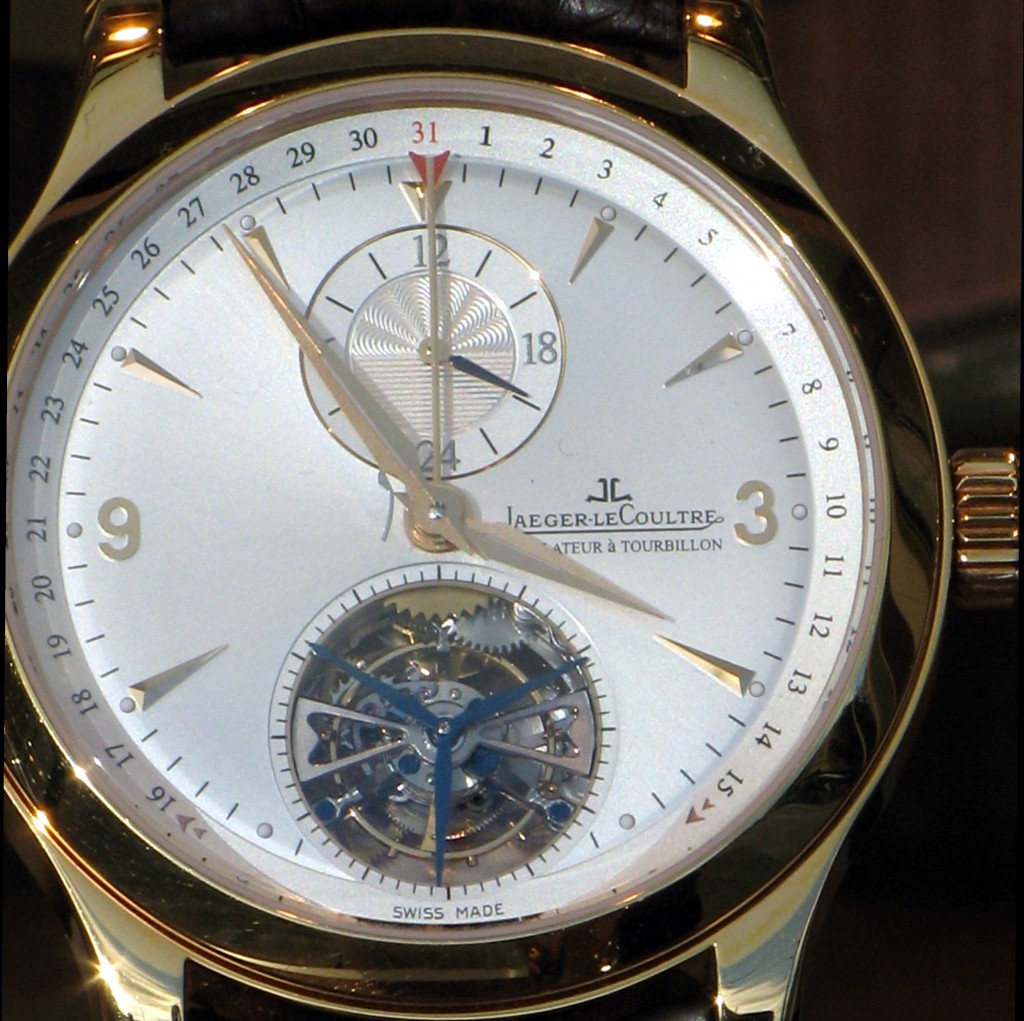
Typically, you’ll find a tourbillon solely in very rare, expensive, entirely handmade automatic or mechanical in-house made movements, that are exclusively utilized by extreme luxury watch brands, known for handmade luxury, and a manufacture of a relatively small number of timepieces per year.
Brands known for using tourbillons:
Brands that are known to use tourbillons, albeit only in a tiny minority of their timepieces, are luxury brands, such as Patek Philippe, Vacheron Constantin, Audemars Piguet, Jaeger LeCoultre, Breguet, Blancpain, Zenith and A. Lange & Söhne. These are 8 brands. 7 of them are Swiss. The only non Swiss brand in this context is the German brand A. Lange & Söhne.
These manufacturers are extremely exclusive luxury watch brands, steeped in an old and glorious tradition, known for old fashioned craftsmanship and handmade luxury, attention to details, and artistry second to none.
Brands that normally wouldn’t use tourbillons:
A standard automatic or mechanical timepiece doesn’t contain a tourbillon.
In this context, even highly prestigious luxury watch brands such as Rolex, Omega, IWC, Breitling, Panerai, Hublot and Cartier, would be considered to be “standard” in comparison to the extreme luxury brands mentioned above. Even less prestigious Swiss luxury brands such as TAG Heuer, Longines and Oris most definitely do not use tourbillons.
For technical reasons, tourbillons are never needed in quartz/battery movements since they aren’t as susceptibe to the Earth’s gravity as automatic and mechanical movements are.
Back To The Frequently Asked Questions & Answers Menu
Article written by Alexander – Founder and Owner of swissdiverswatches.com

If you’ve got any questions or comments, please post them below and I’ll be happy to respond to them!

